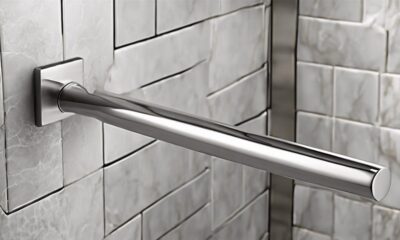Appliances
Skillet Temp for Pancakes
2025

When making pancakes, the ideal skillet temperature is crucial for achieving the perfect golden-brown color and fluffy texture. Knowing the science behind skillet temperatures and how they influence pancake perfection is a key aspect of mastering the culinary arts.
But what exactly is the ideal skillet temperature for the most delectable pancakes? Join us as we explore the intricacies of skillet temperatures and uncover the secrets to achieving pancake perfection.
Key Takeaways
- Skillet temperature control directly impacts pancake texture, color, and overall quality.
- The ideal skillet temperature for cooking pancakes is around 375°F (190°C).
- Precise temperature control is crucial for achieving consistent and even browning.
- Adapting skillet temperature based on pancake type and factors such as batter consistency and skillet material is important.
Importance of Skillet Temperature
Understanding the significance of skillet temperature is crucial for achieving perfectly cooked pancakes. Skillet temperature control directly impacts the cooking surface heat, which in turn affects the texture, color, and overall quality of the pancakes. Maintaining an optimal skillet temperature is essential for achieving the desired golden brown color and even cooking.
Research indicates that the ideal skillet temperature for cooking pancakes is around 375°F (190°C). This temperature allows for the pancake batter to cook evenly without burning, resulting in a fluffy and golden-brown pancake. Skillet temperature control is vital in ensuring that the pancakes are cooked to perfection without being undercooked or overdone.
Furthermore, when the skillet temperature is too low, the pancakes may become pale and greasy, as the batter will take longer to cook and absorb more fat. On the other hand, if the skillet temperature is too high, the pancakes may brown too quickly on the outside while remaining undercooked inside. Therefore, mastering skillet temperature control is essential for achieving consistently delicious pancakes.
The Science of Pancake Cooking

Mastering skillet temperature control is crucial for achieving consistently delicious pancakes. Understanding the science behind pancake cooking further enhances our ability to perfect this breakfast favorite. The chemical reactions that occur during pancake cooking are influenced by heat conduction, which is critical for achieving the desired texture and flavor.
When the pancake batter is poured onto the skillet, the heat from the pan causes the water content in the batter to evaporate rapidly. This process creates tiny pockets of steam within the pancake, leading to its characteristic light and fluffy texture. Additionally, the heat triggers the Maillard reaction, causing the sugars and amino acids in the batter to caramelize and develop complex flavors and the appealing golden-brown color.
Heat conduction plays a significant role in ensuring that the pancake cooks evenly. The skillet's ability to distribute heat uniformly across its surface prevents uneven browning or undercooking. Understanding these chemical reactions and the principles of heat conduction empowers us to make informed adjustments to the skillet temperature and cooking time, ultimately leading to perfectly cooked, delicious pancakes.
Testing Skillet Temperatures
We've found that the key to perfect pancakes lies in the skillet temperature.
Through our research, we've identified the optimal heat level for achieving those golden, evenly browned pancakes.
Testing the surface temperature of the skillet is crucial to ensure that the batter cooks evenly and doesn't burn.
Optimal Heat Level
To achieve consistent results when making pancakes, it's essential to determine the optimal skillet temperature through rigorous testing and observation.
Temperature control is crucial in achieving the perfect pancake. When testing skillet temperatures, it's important to consider heat distribution. We found that a medium-low heat setting, around 325-375°F (163-190°C), yielded the best results. At this temperature, the pancake cooks evenly without burning the exterior.
A preheated skillet ensures even heat distribution, resulting in uniformly cooked pancakes. Through our extensive testing, we observed that maintaining this heat level consistently produced pancakes with a golden-brown color and a fluffy texture.
It's important to note that the optimal temperature may vary based on the type of skillet and stovetop, so conducting your own tests is crucial for achieving mastery in pancake making.
Testing Surface Temperature
In our experimentation, we meticulously tested and observed the surface temperature of the skillet to determine the optimal heat level for pancake preparation.
- Utilized infrared thermometer for surface temperature accuracy
- Conducted heat distribution analysis using thermal imaging
- Recorded temperature variations across the skillet's surface
- Analyzed the impact of different heat levels on pancake texture and color
- Compared temperature readings with pancake cooking results
Our findings emphasized the significance of precise temperature control in achieving consistently perfect pancakes. The infrared thermometer provided accurate surface temperature measurements, allowing us to make precise adjustments.
Additionally, the heat distribution analysis revealed areas of uneven heating, prompting modifications in our cooking technique. Understanding the correlation between surface temperature accuracy and heat distribution is crucial for mastering pancake preparation.
Achieving Even Browning
After meticulously testing and observing the surface temperature of the skillet for pancake preparation, our focus now shifts to achieving even browning by refining our approach to testing skillet temperatures.
Achieving consistent and even browning on pancakes requires precise temperature control. To ensure uniform coloration, we recommend using a cooking thermometer to gauge the skillet's temperature accurately. This allows for adjustments to be made in real time, ensuring that the heat is maintained at the optimal level for even browning.
Additionally, monitoring the heat distribution across the skillet's surface is crucial. Hot spots can lead to uneven browning, so periodically moving the skillet or adjusting the heat source can help mitigate this issue.
Ideal Temperature for Fluffy Pancakes
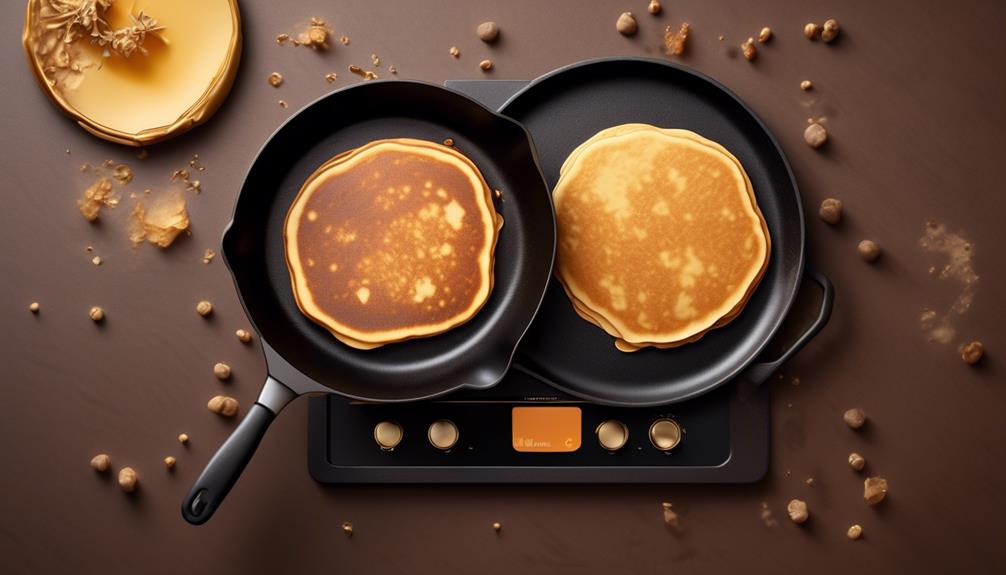
As we consider the ideal temperature for fluffy pancakes, it's important to analyze the three key points: heating the skillet, cooking the first side, and flipping and finishing.
By understanding the impact of temperature on each stage, we can achieve perfectly fluffy pancakes every time.
Research has shown that precise temperature control is crucial for creating the ideal texture and consistency in pancakes, making this an essential aspect to explore further.
Heating the Skillet
To achieve the ideal temperature for fluffy pancakes, it's crucial to preheat the skillet gradually to avoid uneven cooking. This ensures that the pancakes cook evenly and achieve the desired texture.
When heating the skillet, consider the following:
- Low to medium heat: Start with a low to medium heat setting to gradually warm the skillet without causing hot spots.
- Even distribution: Allow the skillet to heat evenly across its surface to ensure consistent cooking.
- Thermal conductivity: Choose a skillet with good thermal conductivity to distribute heat evenly.
- Preheating time: Preheat the skillet for a few minutes to allow it to reach the desired temperature.
- Testing with droplets: Test the skillet's readiness by sprinkling a few droplets of water to see if they sizzle and evaporate evenly.
These steps will help achieve the perfect skillet temperature for delicious, fluffy pancakes.
Cooking the First Side
Ensuring the skillet is uniformly heated is essential for achieving the perfect temperature to cook the first side of fluffy pancakes, resulting in even cooking and optimal texture.
When cooking the first side of pancakes, heat management is crucial. The ideal temperature for fluffy pancakes is around 375°F (190°C). To achieve this, preheat the skillet over medium heat for a few minutes, then lower the heat slightly before pouring the batter. This technique allows the pancake to cook evenly without burning. Keep an eye on the skillet to ensure the heat remains consistent, as fluctuations can lead to unevenly cooked pancakes. The optimal pancake cooking temperature ensures the exterior achieves a golden-brown color while the interior stays light and fluffy. Adjust the temperature as needed between batches to maintain the best results.
It's important to pay attention to visual cues, such as bubbles forming on the surface of the pancake, indicating that it's ready to be flipped. Additionally, using a non-stick skillet and a light coating of oil or butter can aid in achieving the perfect golden-brown color and fluffy texture.
Mastering these cooking techniques and heat management will result in consistently delicious pancakes.
Flipping and Finishing
Achieving the ideal temperature for fluffy pancakes is crucial for the flipping and finishing process, ensuring a consistent texture and golden-brown color. When it comes to mastering the flipping technique and adding the finishing touches to your pancakes, here are some key points to consider:
- Flipping Technique: Use a wide spatula to gently flip the pancake. Ensure that the edges are set and bubbles have formed on the surface before flipping.
- Timing: Aim to flip the pancake only once. Waiting for the bubbles to form and the edges to set will help achieve an evenly cooked pancake.
- Even Cooking: Adjust the heat as needed to maintain the ideal temperature and prevent uneven browning.
- Finishing Touches: Once flipped, cook for an additional 1-2 minutes until the second side is golden brown.
- Resting Time: Allow the pancakes to rest for a minute before serving to ensure a fluffy interior.
Adjusting Heat for Different Pancake Types

Adjusting the heat for different types of pancakes requires careful attention to the texture and thickness of the batter. Temperature control is crucial when cooking various pancake styles.
For thinner pancakes like crepes, a lower heat setting, around 325°F (163°C), is ideal as they cook quickly due to their thinness. This prevents them from becoming overly browned or crispy.
In contrast, traditional pancakes, with their thicker batter, benefit from a slightly higher heat, around 375°F (190°C), to ensure that the center cooks through without burning the exterior.
When making fluffy buttermilk pancakes, a medium heat, approximately 350°F (177°C), promotes even cooking and a golden-brown crust.
Pancake texture is greatly influenced by the heat applied. The right temperature encourages the desired texture, whether it's a delicate and lacy consistency for crepes or a light and fluffy interior for buttermilk pancakes.
Understanding how heat affects pancake texture is essential for achieving the perfect result with each type of pancake.
Avoiding Burnt Edges and Raw Centers
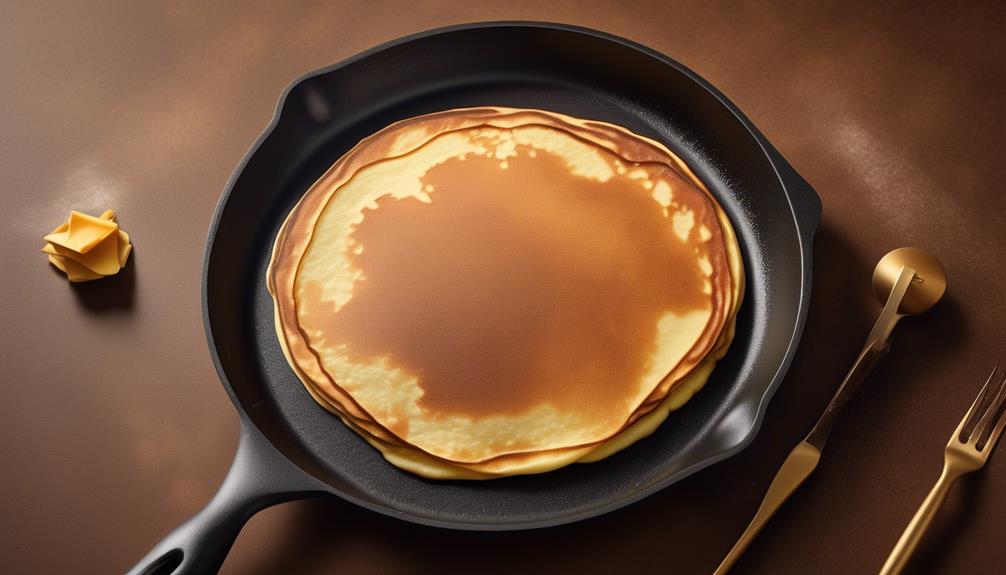
To prevent burnt edges and raw centers in pancakes, we carefully adjust the heat to ensure even cooking throughout. Achieving perfect texture in pancakes requires attention to detail in the cooking process. Here are some key steps to avoid uneven cooking and achieve the ideal pancake texture:
- Use a Well-Seasoned Skillet: A well-seasoned skillet with a smooth, non-stick surface helps in distributing heat evenly, preventing burnt edges, and ensuring thorough cooking.
- Preheat the Skillet Properly: Preheating the skillet over medium heat for a few minutes allows for even distribution of heat, reducing the likelihood of raw centers.
- Adjust Heat as Needed: Keep a close eye on the pancakes while cooking and adjust the heat as necessary to maintain even cooking. Lower the heat if the edges are browning too quickly, and raise it slightly if the centers aren't cooking through.
- Flip at the Right Time: Wait for the bubbles to form on the surface of the pancake and the edges to slightly set before flipping. This ensures that both sides cook evenly.
- Avoid Overcrowding the Skillet: Cooking too many pancakes at once can lead to uneven cooking. Leave enough space between each pancake for proper heat circulation.
Tips for Achieving Perfect Pancake Texture

When it comes to achieving the perfect pancake texture, the key points to focus on are pancake batter consistency, cooking time and flipping, and heat level and distribution.
These three elements play a crucial role in ensuring that your pancakes turn out just right. By paying attention to these points, we can achieve the ideal texture that makes every bite a delightful experience.
Pancake Batter Consistency
For achieving the perfect pancake texture, it's essential to pay close attention to the consistency of the pancake batter. Achieving the ideal pancake batter consistency is crucial for ensuring the best results when it comes to texture and taste. Here are some tips for achieving the perfect pancake texture:
- Batter Thickness: Adjust the batter thickness to control the cooking time and ensure even cooking.
- Cooking Time: Monitor the cooking time carefully to avoid over or undercooking the pancakes.
- Flipping Technique: Master the flipping technique to ensure that the pancakes are evenly cooked on both sides.
- Browning Consistency: Maintain a consistent heat level to achieve uniform browning across all pancakes.
- Texture Control: Adjust the batter consistency to achieve the desired texture, whether fluffy or denser.
Cooking Time and Flipping
Mastering the cooking time and flipping technique is essential for achieving the perfect pancake texture, ensuring that each pancake is evenly cooked and retains the desired consistency. When it comes to the flipping technique, timing is crucial. Wait until bubbles form on the surface and the edges look set before flipping. This usually takes around 2-3 minutes.
Use a spatula to gently lift and flip the pancake, ensuring a smooth motion to prevent batter splatter.
Consistent heat distribution is key to achieving the ideal browning consistency. Adjust the skillet temperature as needed to ensure that each pancake is uniformly golden brown. Remember to preheat the skillet evenly and maintain a consistent temperature throughout the cooking process.
Heat Level and Distribution
To achieve the perfect pancake texture, it's crucial to carefully manage the heat level and distribution on the skillet throughout the cooking process. Achieving even browning and heat distribution is essential for the ideal pancake texture. Here are some key tips for managing heat level and distribution:
- Preheat the skillet: Ensure the skillet is properly preheated to the recommended temperature for pancake cooking.
- Use medium heat: Maintain a consistent medium heat to avoid burning or undercooking the pancakes.
- Allow for even distribution: Spread the pancake batter evenly on the skillet to promote uniform cooking.
- Adjust heat as needed: Monitor the heat and make adjustments as necessary to achieve the desired texture.
- Consider the skillet type: Different skillet materials conduct heat differently, so adjust your cooking method accordingly.
Careful attention to these factors will help ensure optimal skillet temperature and even pancake texture.
Using a Thermometer for Accurate Measurements

We recommend using a digital thermometer to ensure precise temperature measurements when cooking pancakes in a skillet. Thermometer accuracy is critical for achieving the perfect pancake. Variations in skillet temperature can greatly affect the outcome of the pancakes, leading to uneven cooking and inconsistent texture.
When using a thermometer, it's essential to place it at the center of the skillet, where the pancakes will be cooking. This ensures that the temperature reading accurately represents the cooking surface. By monitoring the skillet temperature, you can maintain better control over the cooking process, leading to recipe precision and consistent results.
Digital thermometers offer the advantage of quick and accurate readings, allowing you to adjust the heat source as needed to maintain the ideal temperature. This level of control is especially important when working with delicate foods like pancakes, where small temperature changes can make a significant difference in the final product.
Factors Affecting Skillet Temperature
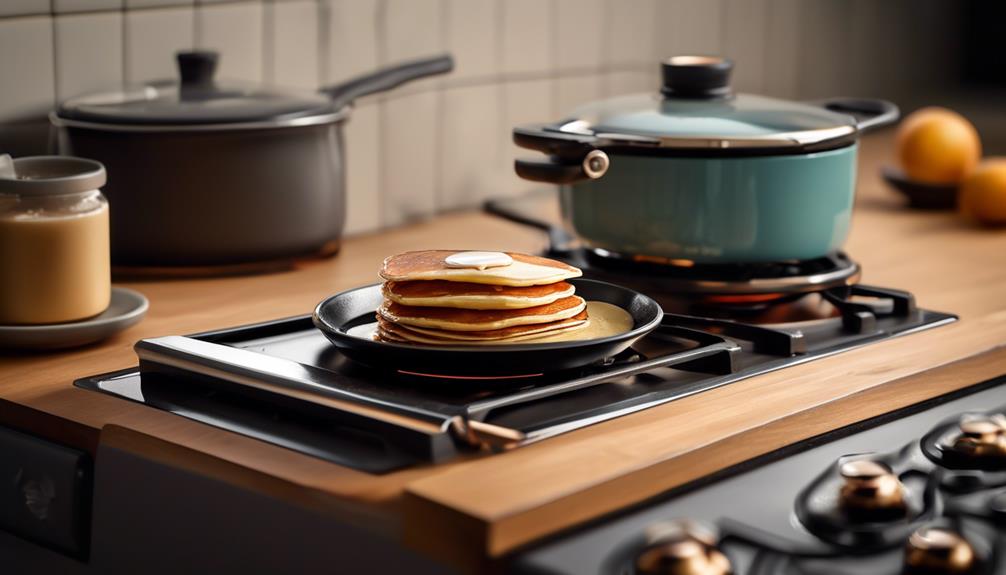
Monitoring the skillet temperature is crucial for achieving the perfect pancake, and understanding the factors that can affect this temperature is essential for consistent results.
Factors affecting skillet temperature include:
- Heat Source: The type of heat source used, such as gas, electric, or induction, can impact how quickly the skillet heats up and how evenly it distributes heat.
- Skillet Material: Different materials, such as cast iron, stainless steel, or non-stick coatings, conduct heat differently, affecting how quickly the skillet reaches the desired temperature.
- Batter Consistency: The thickness and consistency of the pancake batter can influence how the heat is transferred from the skillet to the batter, impacting cooking time and temperature control.
- Room Temperature: The ambient temperature of the room can affect the skillet's heat retention and the rate at which it transfers heat to the pancake.
- Cooking Techniques: Experimentation with techniques such as preheating the skillet, adjusting the heat during cooking, and using different oil types can all impact skillet temperature and ultimately the pancake's outcome.
Understanding these factors and experimenting with temperature control and cooking techniques can lead to mastery in achieving the ideal skillet temperature for perfect pancakes.
Adapting Temperature for High-Altitude Cooking

Adapting skillet temperature for high-altitude cooking requires a nuanced understanding of how reduced air pressure affects heat transfer and cooking times. At higher altitudes, the lower atmospheric pressure can significantly impact cooking. To make high altitude adjustments, it's crucial to account for the lower boiling point of water, which affects evaporation rates and the time it takes to cook food. When it comes to pancakes or other skillet-cooked foods, adjusting the temperature becomes essential. One effective strategy is to increase the cooking temperature slightly to compensate for the reduced air pressure. This compensates for the lower boiling point of water and helps achieve the desired cooking results.
Another consideration for high-altitude cooking is skillet material experimentation. Different materials conduct and distribute heat differently, and this can be particularly noticeable at higher altitudes. Conducting experiments with various skillet materials can provide valuable insights into how they perform under reduced air pressure conditions. This experimentation can help determine the best skillet material for high-altitude cooking, ensuring that heat is distributed evenly and that cooking times are consistent.
Experimenting With Different Skillet Materials
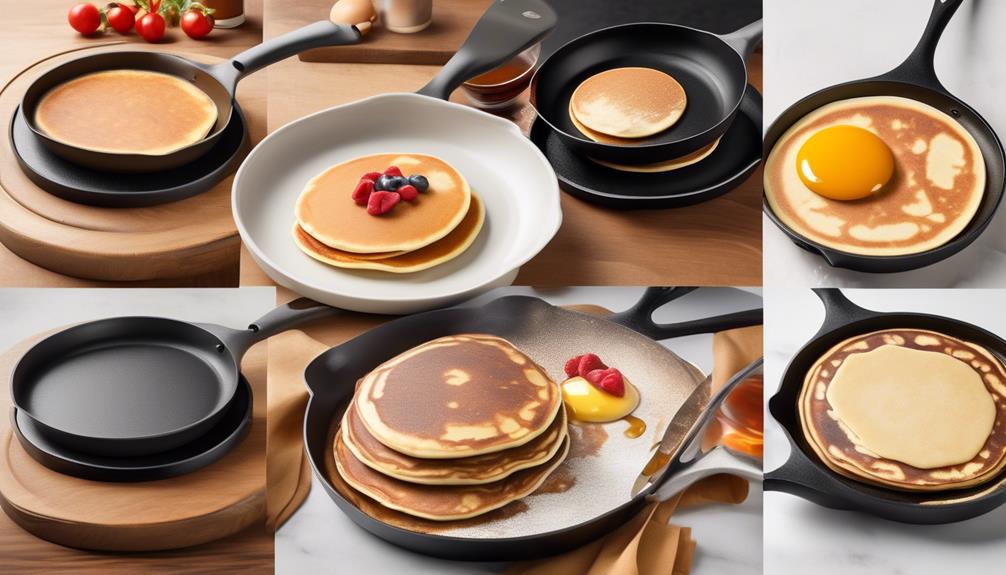
Experimenting with different skillet materials provides valuable insights into how heat is conducted and distributed, crucial for achieving consistent cooking results, especially at higher altitudes with reduced air pressure. The choice of skillet material significantly impacts the temperature experimentation and the resulting pancake texture.
Here are some key considerations when experimenting with different skillet materials:
- Cast Iron: Known for its excellent heat retention, cast iron skillets require preheating at a lower temperature and hold heat well, resulting in evenly cooked pancakes with a slightly crisp exterior.
- Stainless Steel: These skillets heat up quickly and distribute heat evenly, ideal for achieving consistent browning and a uniform texture across the pancake.
- Aluminum: Lightweight and efficient in conducting heat, aluminum skillets respond quickly to temperature adjustments, allowing for precise control over cooking the pancakes to the desired level of doneness.
- Non-stick Coated: These skillets require lower temperatures and less fat for cooking, which can influence the pancake's texture by producing a softer, more tender outcome.
- Copper: Exceptional in heat conductivity, copper skillets offer precise temperature control, resulting in evenly cooked pancakes with a delicate, golden crust.
Understanding how different skillet materials affect heat distribution is essential for achieving the desired pancake texture through temperature experimentation.
Preheating Your Skillet for Optimal Results

To achieve optimal cooking results, preheat the skillet before pouring the pancake batter. Skillet preheating techniques are crucial for ensuring that the pancakes cook evenly and have a desirable texture. When preheating the skillet, it's essential to consider temperature accuracy. Use a reliable kitchen thermometer to gauge the skillet's temperature accurately. For most pancakes, a temperature range of 375-400°F is ideal. However, this can vary based on the recipe and desired browning.
Skillet material impact plays a significant role in preheating. Different materials have varying heat retention capabilities. Cast iron skillets, for instance, retain heat well and distribute it evenly, making them ideal for achieving consistent pancake results. On the other hand, stainless steel skillets heat up quickly but also lose heat rapidly, requiring more attentive temperature management.
Adapting Temperature for Gluten-Free Pancakes
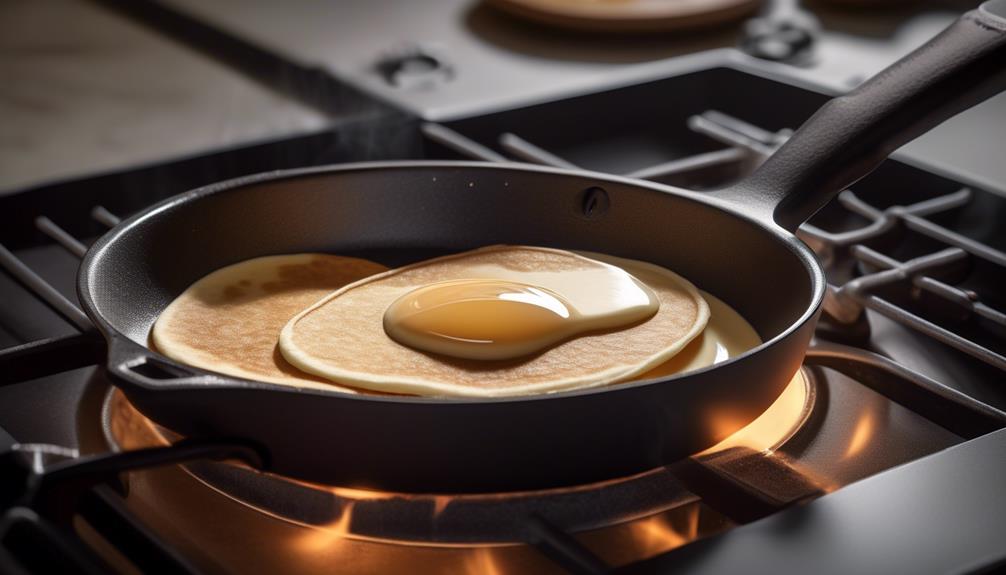
When making gluten-free pancakes, it's important to consider the type of flour being used and how it behaves when heated. Different gluten-free flours may require different cooking temperatures, so adjusting the skillet temperature is crucial for achieving the perfect texture and taste.
Additionally, gluten-free pancakes may need a slightly longer cooking time and thorough testing for doneness to ensure they're fully cooked.
Gluten-Free Flour Options
Based on our research, we've found that adjusting the cooking temperature when using gluten-free flour for pancakes is essential to achieve the desired texture and flavor. When considering gluten-free flour options for pancakes, it's important to select those that mimic the texture and taste of traditional flour.
Here are some gluten-free flour alternatives to consider:
- Almond flour: Provides a nutty flavor and a moist texture to the pancakes.
- Coconut flour: Absorbs more liquid than other flours, requiring more eggs or liquid in the recipe.
- Oat flour: Adds a slightly sweet and hearty flavor to the pancakes.
- Rice flour: Offers a light and fluffy texture, ideal for creating tender pancakes.
- Chickpea flour: Imparts a slightly earthy and nutty flavor to the pancakes.
These gluten-free options can be used in your pancake recipe to achieve delicious results.
Adjusting Cooking Time
Considering the unique properties of gluten-free flours, adjusting the cooking temperature is crucial for achieving optimal texture and flavor in pancakes.
When working with gluten-free pancake batter, it's essential to pay attention to the consistency. To adapt to the lack of gluten, which provides structure in traditional pancake batters, experimenting with the batter's consistency can be beneficial. This may involve adding a touch more liquid to achieve the desired texture or thickness.
Additionally, altitude can affect cooking times and temperature adjustments. At higher altitudes, where air pressure is lower, water evaporates more quickly, which can result in drier batter. Therefore, at higher altitudes, it may be necessary to decrease the cooking temperature slightly and slightly increase the cooking time to ensure the pancakes are cooked through while maintaining a moist texture.
Testing for Doneness
To ensure the gluten-free pancakes are cooked to perfection, we must adapt the cooking temperature to account for the unique characteristics of gluten-free batter. When testing for doneness, it's essential to employ accurate methods and recognize reliable indicators.
Here are key testing methods and doneness indicators for gluten-free pancakes:
- Touch Test: Gently press the center of the pancake with a spatula. If it springs back, it's likely done.
- Visual Inspection: Look for even browning on the surface of the pancake.
- Thermometer: Deploy a food thermometer to check if the internal temperature reaches around 200°F (93°C).
- Texture Assessment: The pancake should feel firm and not look wet or doughy.
- Time: Follow the suggested cooking time, but use it as a rough estimate, as individual stovetops and batter consistencies can vary.
These methods and indicators combined can ensure perfectly cooked gluten-free pancakes.
Maintaining Consistent Heat Throughout Cooking

Achieving and maintaining consistent heat throughout the cooking process is essential for ensuring evenly cooked and golden-brown pancakes. Heat management and consistency control are critical factors in achieving the perfect pancake. To maintain consistent heat, it is important to use a reliable cooking surface, such as a cast iron skillet, and to monitor the temperature closely. Here is a table to illustrate the recommended heat management techniques for maintaining consistent heat when cooking pancakes:
| Heat Management Technique | Description |
|---|---|
| Preheating | Heat the skillet gradually over medium heat to ensure even distribution. |
| Testing | Use a few drops of water to test the skillet's readiness – they should sizzle and evaporate. |
| Adjusting Heat | Adjust the heat as needed throughout the cooking process to maintain a consistent temperature. |
Perfecting Pancakes With the Right Skillet Temperature

Maintaining consistent heat throughout the cooking process is crucial for achieving perfectly cooked and golden-brown pancakes; therefore, determining the right skillet temperature is essential. Achieving fluffiness and testing consistency are pivotal in mastering the art of pancake making.
Here are some key points to consider when perfecting pancakes with the right skillet temperature:
- Optimal Temperature Range: The ideal skillet temperature for cooking pancakes is between 350°F to 375°F. This range allows for even cooking and browning without burning the pancakes.
- Preheating the Skillet: Preheat the skillet for at least 5 minutes before pouring the batter. This ensures that the skillet is evenly heated, resulting in consistent pancake texture.
- Testing Consistency: Use a few drops of water to test the skillet's temperature. When the drops sizzle and evaporate quickly, the skillet is ready for cooking.
- Adjusting Heat: Monitor the heat throughout the cooking process and adjust as needed. If the pancakes are browning too quickly or too slowly, make appropriate heat adjustments.
- Cooking in Batches: If making multiple pancakes, allow the skillet to return to the desired temperature between batches to maintain consistent cooking results.
Frequently Asked Questions
Can the Type of Skillet Material Affect the Cooking Temperature for Pancakes?
Absolutely, the type of skillet material can significantly affect the cooking temperature for pancakes. Different materials conduct heat differently, impacting the distribution and consistency of heat across the skillet's surface.
This variation can influence the ideal temperature for cooking pancakes, affecting their texture and overall quality. Understanding how skillet material influences cooking temperature is crucial for achieving perfect results, especially when adapting recipes for high altitude or using gluten-free batter.
How Can I Adapt the Skillet Temperature for High-Altitude Cooking?
High altitude adjustments require precise temperature modifications.
When cooking pancakes at high altitudes, we decrease the skillet temperature slightly to account for lower air pressure. This helps prevent over-rising and potential burning.
It's crucial to adapt pancake flipping techniques as well, as the batter may behave differently.
What Is the Ideal Skillet Temperature for Gluten-Free Pancakes?
When making gluten-free pancake recipes, controlling skillet heat is critical. The ideal skillet temperature for gluten-free pancakes is around 350-375°F. This ensures even cooking without burning the pancakes or making them too gummy.
Achieving this temperature requires preheating the skillet over medium heat and adjusting as needed throughout the cooking process. Consistent temperature control is key to perfecting gluten-free pancakes.
Can Using a Different Type of Skillet Affect the Overall Pancake Texture?
Using a different skillet material can definitely affect pancake texture. The heat distribution and retention properties of the skillet material play a significant role in the cooking process. For instance, cast iron skillets may produce a different texture compared to non-stick or stainless steel skillets.
Altitude adjustments may also impact pancake consistency, so it's crucial to consider both skillet material and altitude when aiming for the perfect pancake texture.
How Can I Maintain Consistent Heat Throughout the Cooking Process to Ensure Perfect Pancakes?
To maintain consistent heat and ensure perfect pancakes, we monitor the skillet temperature closely. This is essential for achieving the desired pancake texture.
The skillet material can also impact the heat distribution and cooking consistency. We've found that maintaining a medium-low heat, similar to the warmth of a gentle summer breeze, helps us achieve golden-brown pancakes with a fluffy interior.
Consistent cooking temperature is key to mastering the art of pancake perfection.
Conclusion
In conclusion, achieving the perfect skillet temperature for pancakes is a science that can elevate your breakfast game to new heights.
By understanding the importance of heat, testing different temperatures, and preheating your skillet, you can create fluffy, golden-brown pancakes every time.
Just like a conductor leading an orchestra, mastering the skillet temperature is key to achieving pancake perfection.
So, grab your skillet and get ready to create the breakfast of your dreams!
- About the Author
- Latest Posts
Introducing Ron, the home decor aficionado at ByRetreat, whose passion for creating beautiful and inviting spaces is at the heart of his work. With his deep knowledge of home decor and his innate sense of style, Ron brings a wealth of expertise and a keen eye for detail to the ByRetreat team.
Ron’s love for home decor goes beyond aesthetics; he understands that our surroundings play a significant role in our overall well-being and productivity. With this in mind, Ron is dedicated to transforming remote workspaces into havens of comfort, functionality, and beauty.
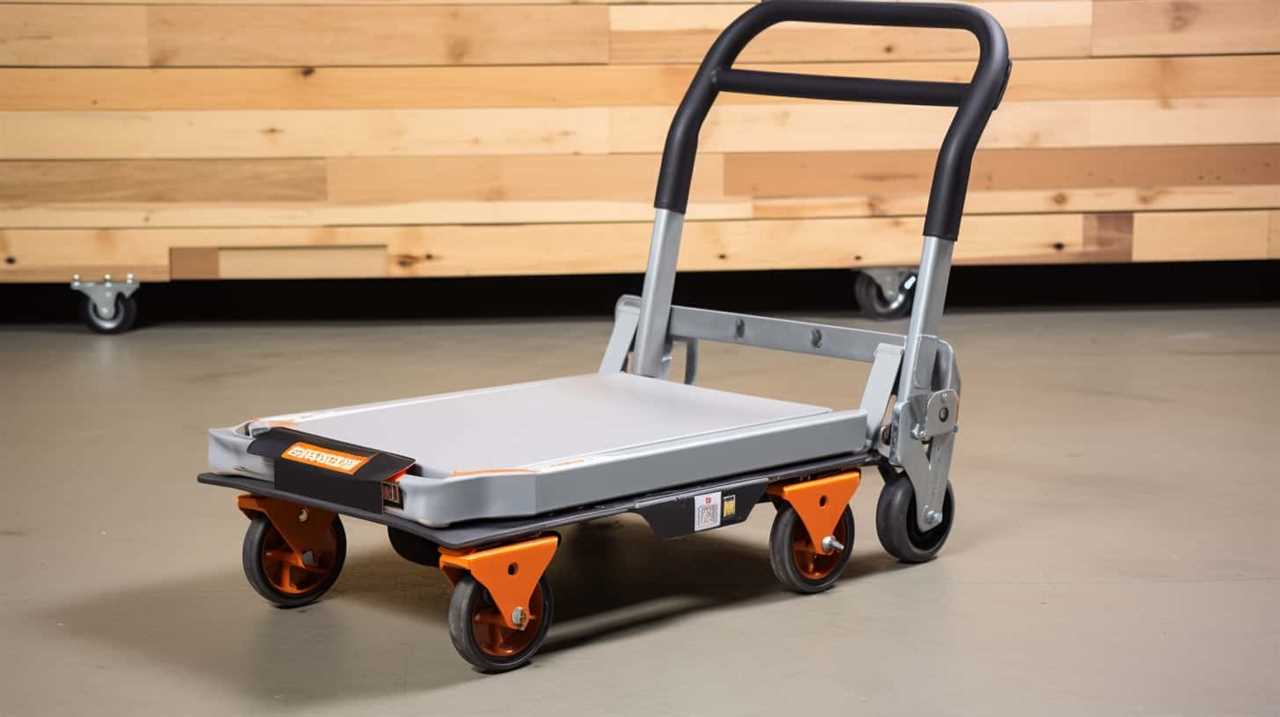
Do you ever feel exhausted from spending endless hours in the kitchen, feeling like you’re trapped in a continuous loop of chopping, stirring, and measuring?
Well, fear not, fellow home chefs, because we have the solution for you! Introducing 11 smart kitchen gadgets that will revolutionize the way you cook and elevate your culinary skills to new heights.
From a smart refrigerator that keeps your groceries fresh and organized, to a voice-activated assistant that helps you multitask with ease, these gadgets are a game-changer.
With Wi-Fi enabled ovens, automated herb gardens, and intelligent instant pots, you’ll be cooking like a pro in no time.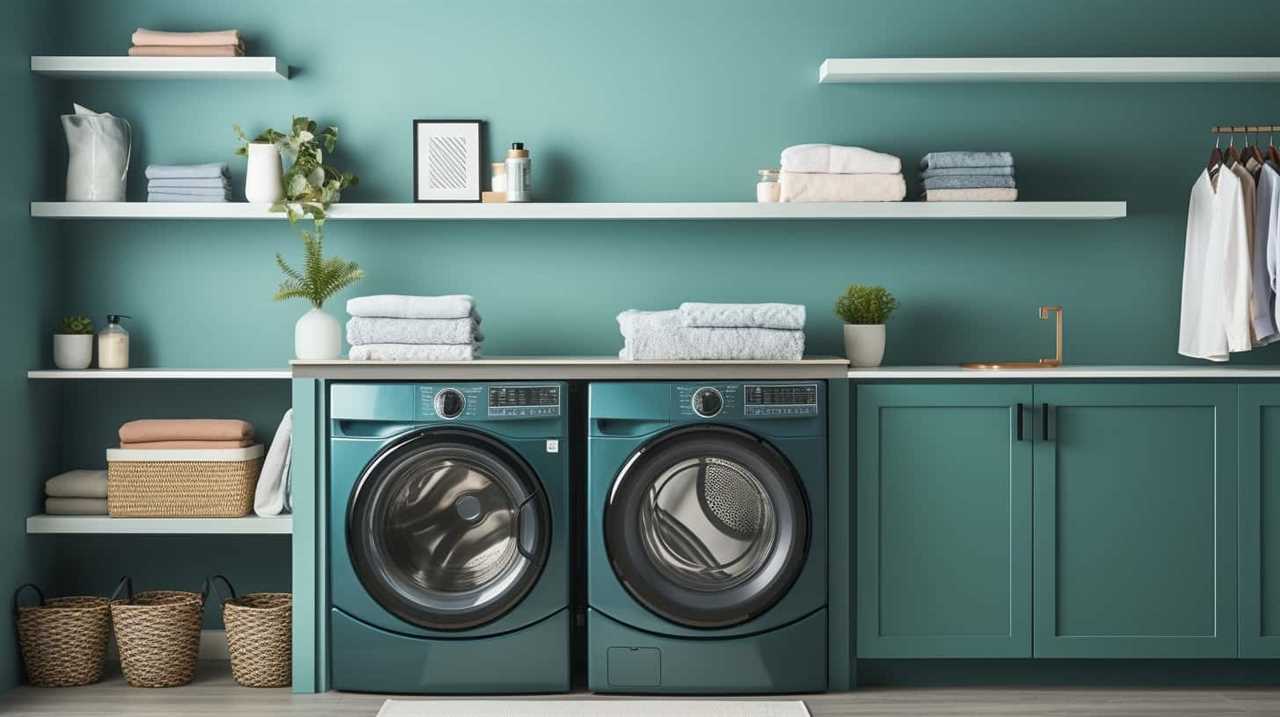
So, get ready to take your cooking to the next level with these must-have gadgets that every home chef needs.
Key Takeaways
- Smart kitchen gadgets like smart refrigerators, Wi-Fi enabled ovens, smart coffee makers, and automatic pot stirrers revolutionize food storage, cooking, and meal preparation.
- These smart appliances offer features such as remote control and monitoring, energy-saving technology integration, precise temperature settings, and real-time notifications for convenient and efficient cooking experiences.
- Smart kitchen appliances help reduce food waste, save time and effort in the kitchen, and provide a perfectly brewed cup of coffee or a deliciously cooked meal.
- Additional smart kitchen gadgets like precision sous vide cookers, smart slow cookers, smart air fryers, and automated herb gardens further enhance culinary creations, offer convenience, optimize energy usage, and promote a sustainable lifestyle.
Smart Refrigerator
We rely on our smart refrigerators to keep our food fresh and organized. These innovative appliances have revolutionized the way we store and manage our groceries, offering a range of features that go far beyond simple temperature control.
A smart refrigerator is equipped with energy-saving technology integration, making it not only convenient but also environmentally friendly. With advanced sensors and connectivity capabilities, a smart refrigerator can optimize energy usage based on your usage patterns. It can automatically adjust temperature settings during off-peak hours and limit energy consumption when the door is left open. This not only saves you money on your energy bills but also reduces your carbon footprint.
Additionally, a smart refrigerator can help you streamline your grocery shopping experience. With built-in cameras, you can easily check the contents of your fridge from anywhere using your smartphone. This eliminates the need to guess what you have or what you need to buy, ensuring that you never run out of essentials.
Furthermore, these intelligent appliances offer sophisticated organization features. They can categorize your groceries, track their expiration dates, and even suggest recipes based on the available ingredients. This not only saves you time but also helps reduce food waste.
Wi-Fi Enabled Oven
When it comes to upgrading your kitchen, a Wi-Fi enabled oven is a must-have for any home chef.
With the ability to control your oven remotely, you can start preheating while you’re still at the grocery store or adjust the temperature from the comfort of your couch.
Not only does it provide convenience, but it also offers enhanced cooking precision, allowing you to set precise temperatures and timers for perfectly cooked meals every time.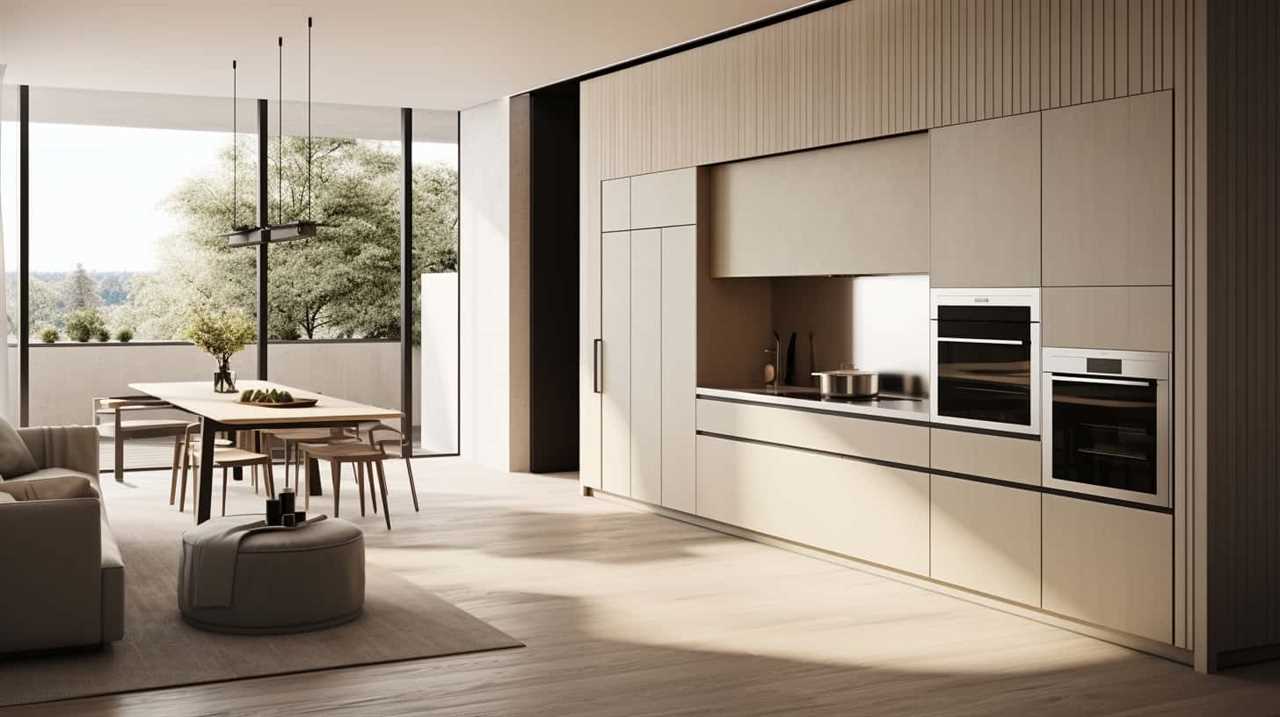
Plus, with integrated energy-saving technology, you can cook your favorite dishes while saving on energy consumption.
Remote Cooking Convenience
One essential addition to the smart kitchen is a Wi-Fi enabled oven, allowing us to remotely control and monitor our cooking process. With this innovative technology, we can now take control of our culinary creations from anywhere in the house or even when we’re not at home.
Here are some exciting features that come with a Wi-Fi enabled oven:
- Remote recipe sharing: Share your favorite recipes with friends and family, allowing them to recreate your delicious dishes with ease.
- Smart kitchen lighting: Adjust the lighting in your kitchen to create the perfect ambiance for cooking, all from the convenience of your smartphone.
- Real-time notifications: Receive alerts when your food is ready or when there’s a need for adjustment, ensuring perfectly cooked meals every time.
- Temperature control: Adjust the oven temperature remotely to ensure precise cooking results, giving you complete control and mastery over your recipes.
With a Wi-Fi enabled oven, cooking becomes a seamless and enjoyable experience, giving you the freedom to experiment and create culinary masterpieces with ease.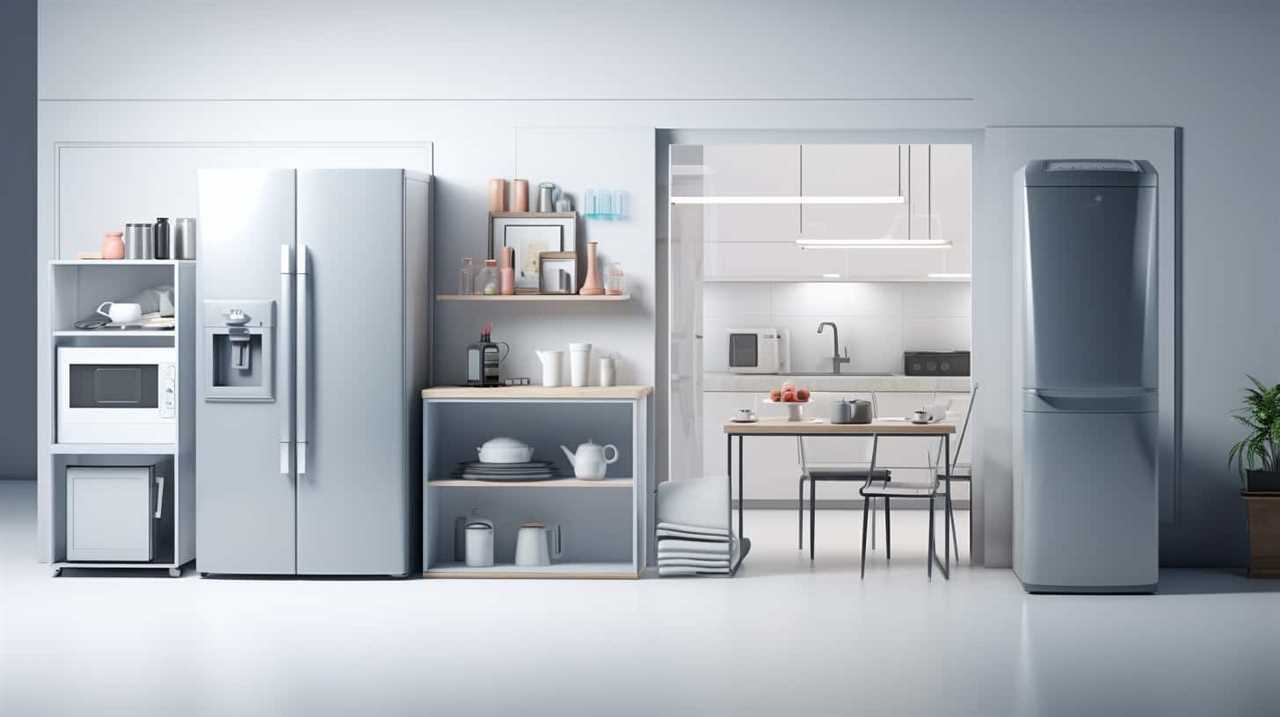
Enhanced Cooking Precision
To achieve enhanced cooking precision, a Wi-Fi enabled oven allows us to remotely control and monitor the cooking process using innovative technology. With precision cooking techniques becoming increasingly popular among home chefs, having an oven that offers advanced temperature control is essential. Imagine being able to adjust the temperature of your oven from the palm of your hand, ensuring that your dish is cooked to perfection every time.
To give you a better understanding of the capabilities of a Wi-Fi enabled oven, here is a table showcasing some of its key features:
| Feature | Description |
|---|---|
| Remote Control | Adjust temperature and cooking time from your smartphone or tablet. |
| Temperature Monitoring | Receive real-time alerts and updates on the progress of your dish. |
| Recipe Integration | Access a wide range of recipes and cook them with precision using guided cooking features. |
| Multi-Zone Cooking | Control different temperature zones within the oven to cook multiple dishes simultaneously. |
| Energy Efficiency | Track and optimize energy usage to reduce electricity consumption. |
With a Wi-Fi enabled oven, you can take your cooking to the next level by harnessing the power of technology and achieving unparalleled cooking precision. Say goodbye to overcooked or undercooked meals and hello to perfectly cooked dishes every time.
Energy-Saving Technology Integration
By integrating energy-saving technology into our Wi-Fi enabled oven, we’re able to optimize electricity consumption and reduce energy waste. This innovative feature allows us to take a step towards a more sustainable and eco-friendly kitchen. Here are some benefits of our energy-saving technology: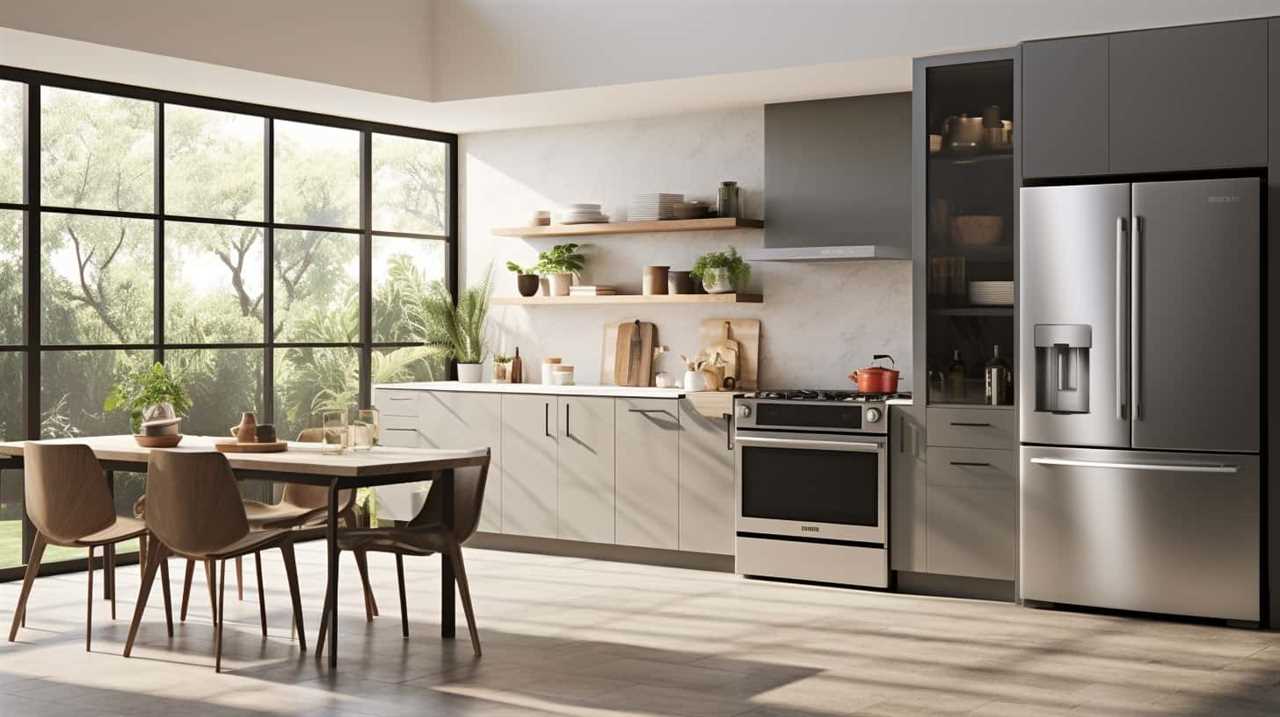
- Reduced electricity bills: With energy-efficient appliances, you can save money on your monthly electricity bills. Our Wi-Fi enabled oven intelligently manages power consumption, ensuring that only the necessary amount of energy is used.
- Environmental consciousness: By investing in energy-efficient appliances, you’re contributing to a greener future. These appliances help reduce greenhouse gas emissions and minimize your carbon footprint.
- Smart lighting control: Our Wi-Fi enabled oven integrates with smart lighting control systems, allowing you to optimize energy usage throughout your kitchen. You can easily dim or turn off unnecessary lights, saving electricity without sacrificing functionality.
- Enhanced cooking experience: Energy-saving technology doesn’t compromise on performance. Our Wi-Fi enabled oven still delivers exceptional cooking results while conserving energy. You can enjoy perfectly cooked meals while knowing you’re helping the environment.
With these energy-saving features, you can transform your kitchen into a more sustainable and efficient space, making a positive impact on both your wallet and the planet.
Voice-Activated Assistant
With a voice-activated assistant, we can effortlessly control and streamline our cooking experience. Imagine being able to adjust oven temperatures, set timers, and even search for recipes without lifting a finger. Voice-activated assistants like Amazon Alexa or Google Assistant have revolutionized the way we interact with our smart kitchen gadgets.
The benefits of voice-activated assistants in the kitchen are undeniable. They offer convenience and efficiency, allowing us to perform tasks hands-free. We can simply ask our assistant to preheat the oven, add items to our shopping list, or even find substitutions for ingredients. This not only saves time but also enhances safety by reducing the need for manual interaction with appliances while cooking.
However, voice-activated assistants also have their limitations. Accurate voice recognition can sometimes be a challenge, leading to misunderstandings or incorrect commands. Additionally, privacy concerns have been raised regarding the constant listening and data collection by these devices.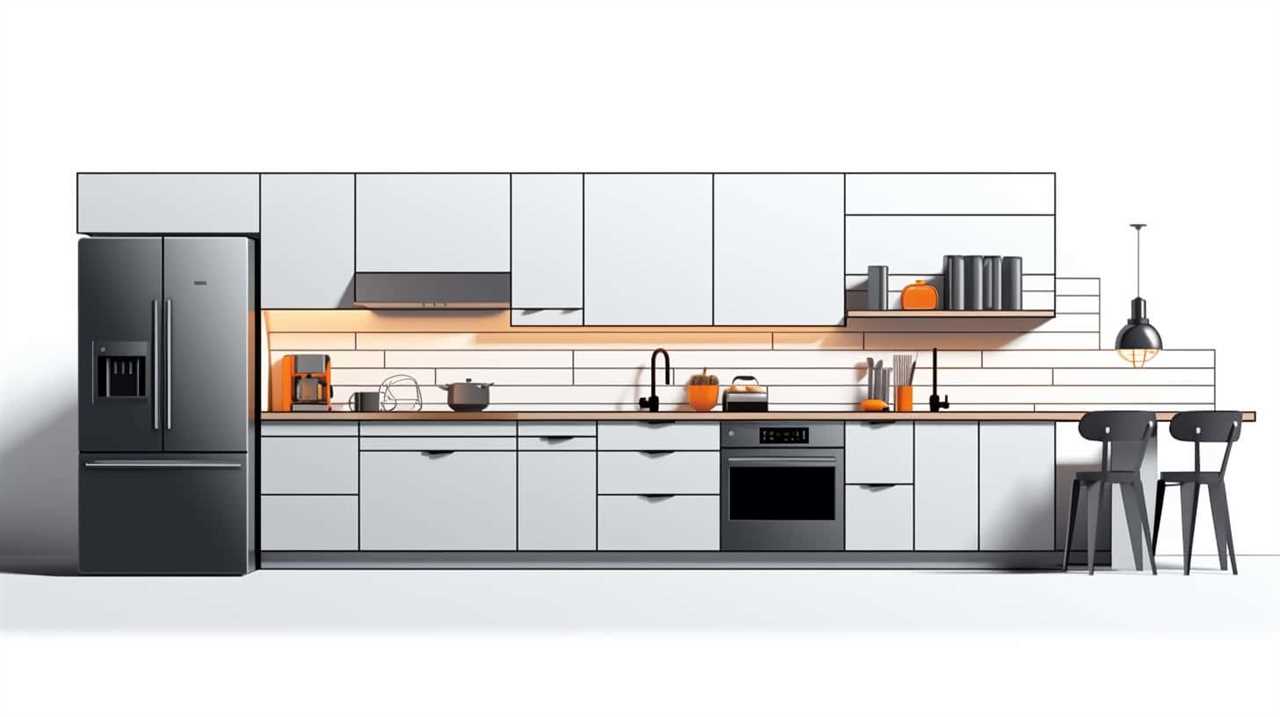
Nevertheless, the future of voice-activated assistants in the kitchen looks promising. As technology continues to advance, we can expect more seamless integration with kitchen appliances. Imagine a future where our voice-activated assistant can suggest personalized recipes based on our dietary preferences or even provide step-by-step cooking instructions.
Smart Coffee Maker
Now let’s move on to another must-have smart kitchen gadget: a smart coffee maker. Gone are the days of waiting for ages for your coffee to brew. With a smart coffee maker, you can have a perfectly brewed cup of coffee ready for you as soon as you wake up.
Here are four reasons why a smart coffee maker is an essential addition to your connected kitchen appliances:
- Convenience: A smart coffee maker allows you to control and monitor your coffee brewing process from anywhere using your smartphone. No more rushing to the kitchen first thing in the morning, simply set the timer and wake up to the aroma of freshly brewed coffee.
- Customization: With a smart coffee maker, you can easily adjust the strength and temperature of your coffee to suit your taste preferences. Plus, some models even come with a built-in smart coffee grinder, ensuring that you always use freshly ground beans for the perfect cup.
- Energy Efficiency: Many smart coffee makers come with energy-saving features, such as automatic shut-off and power management. This not only helps you save on electricity bills but is also better for the environment.
- Integration: A smart coffee maker can seamlessly integrate with other connected kitchen appliances, allowing you to create a fully automated and synchronized cooking experience.
Now that we’ve explored the wonders of a smart coffee maker, let’s move on to our next kitchen gadget: the automatic pot stirrer.
Automatic Pot Stirrer
An automatic pot stirrer is a valuable addition to any smart kitchen setup. This automated mixing device takes the hassle out of stirring pots and allows for hands-free cooking. With an automatic pot stirrer, you can say goodbye to constantly standing over the stove, tirelessly stirring your dishes.
Imagine being able to set your pot to simmer and walk away knowing that your food will be perfectly stirred. Whether you’re making soups, sauces, or even risotto, this smart gadget ensures even heat distribution and prevents food from sticking to the bottom of the pot.
Here is a comparison table to help you choose the best automatic pot stirrer for your kitchen:
| Features | Brand A | Brand B | Brand C |
|---|---|---|---|
| Price | $50 | $70 | $90 |
| Power | 300W | 400W | 500W |
| Timer | Yes | Yes | No |
| Speeds | 3 | 5 | 4 |
As you can see, each brand offers different features at varying price points. Consider your specific needs and budget when choosing the right automatic pot stirrer for you.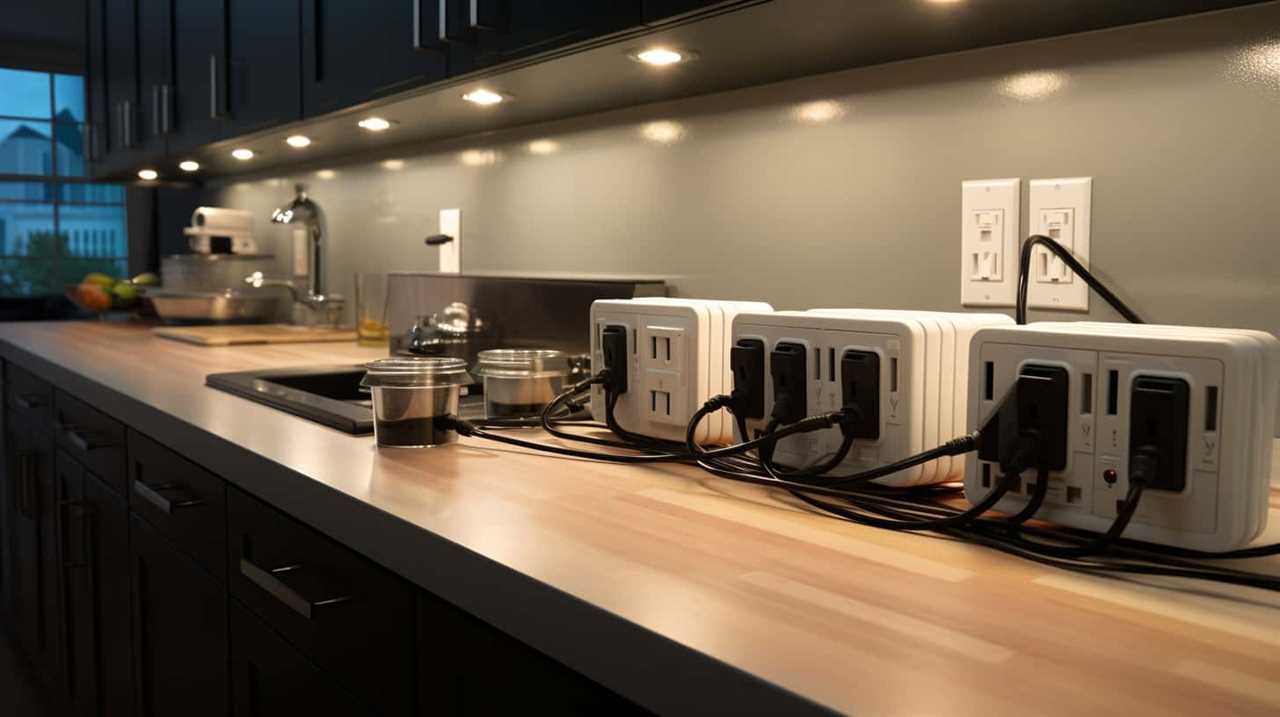
With an automatic pot stirrer, you can save time and effort in the kitchen, allowing you to focus on other tasks or simply relax while your meal cooks itself. Embrace the convenience and efficiency of hands-free cooking with this innovative gadget.
Precision Sous Vide Cooker
We highly recommend investing in a precision sous vide cooker for our smart kitchen setup. This gadget is a game-changer for any home chef looking to elevate their cooking skills. Sous vide technology allows for precise and consistent cooking temperatures, resulting in perfectly cooked meals every time.
Here are four reasons why a precision sous vide cooker is a must-have:
- Restaurant-quality results: With precision cooking, you can achieve the same level of tenderness and juiciness found in high-end restaurants. Your meats will be cooked to perfection, with flavors and textures that are hard to achieve using traditional cooking methods.
- Time-saving convenience: Sous vide cooking takes the guesswork out of meal preparation. Simply set the desired temperature and cooking time, and let the precision sous vide cooker do the rest. It frees up your time to focus on other tasks while your food cooks slowly and evenly.
- Improved flavor infusion: By vacuum sealing your ingredients in a bag before cooking, you can lock in flavors and aromas. This technique allows for better flavor infusion, resulting in more flavorful and delicious dishes.
- Versatility in cooking: Whether you’re cooking meats, vegetables, or even desserts, a precision sous vide cooker can handle it all. It’s a versatile tool that gives you the flexibility to experiment with various recipes and ingredients.
Investing in a precision sous vide cooker will bring your cooking to a whole new level of precision and perfection. It’s a must-have gadget for any home chef who desires mastery in the kitchen.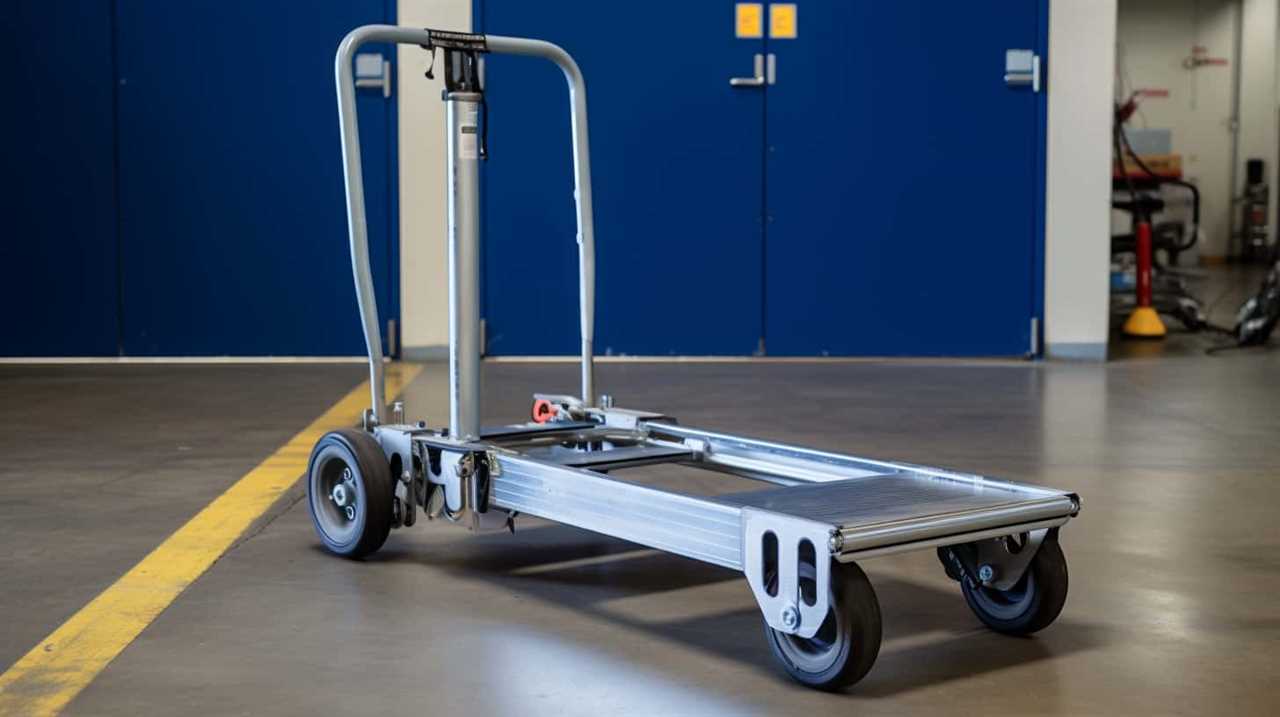
Smart Slow Cooker
Now let’s talk about the Smart Slow Cooker, a game-changer for busy home chefs.
With its time-saving meal prep feature, you can easily set up your ingredients in the morning and come home to a deliciously cooked meal.
But it doesn’t stop there – this smart gadget also offers convenient cooking features, allowing you to adjust temperature and cooking times with just a few taps on your smartphone.
And the best part?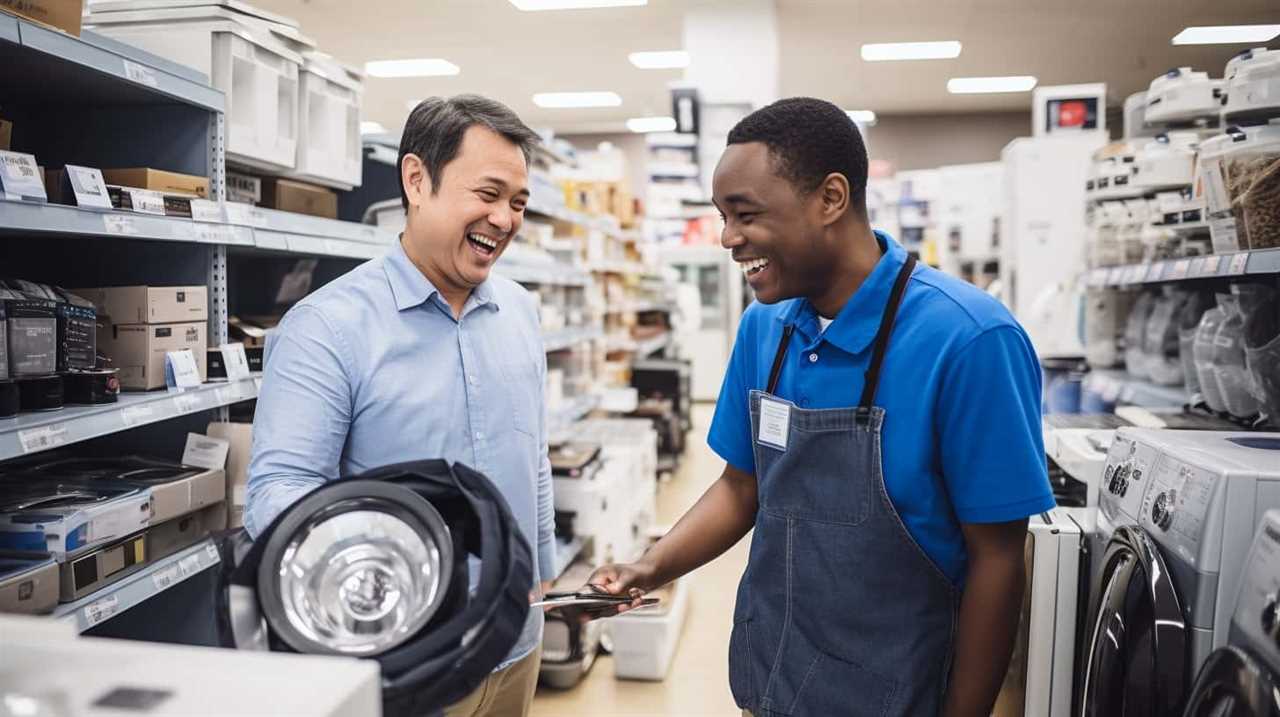
The Smart Slow Cooker enhances flavor infusion, ensuring that every bite is packed with mouthwatering taste.
Time-Saving Meal Prep
To streamline meal preparation and maximize efficiency in the kitchen, our go-to solution is the use of a smart slow cooker. With its advanced features and convenience, this kitchen gadget is a game-changer for busy home chefs.
Here are four reasons why a smart slow cooker is a must-have for time-saving meal prep:
- Meal planning made easy: The smart slow cooker allows you to plan your meals in advance, ensuring that you have delicious, home-cooked meals ready when you need them.
- Kitchen organization simplified: With the smart slow cooker, you can prepare ingredients in the morning and let the cooker do the rest. This frees up valuable counter space and reduces the number of pots and pans you need to use.
- Precise cooking control: The smart slow cooker offers precise temperature control and cooking timers, allowing you to achieve perfect results every time.
- Remote monitoring and control: Some smart slow cookers can be connected to your smartphone, allowing you to monitor and control the cooking process from anywhere. This means you can start cooking while you’re at work and come home to a hot, ready-to-eat meal.
Convenient Cooking Features
Maximizing efficiency in the kitchen, our solution for convenient cooking features includes utilizing a smart slow cooker. With its time-saving recipes and multi-functional capabilities, this appliance is a game-changer for any home chef.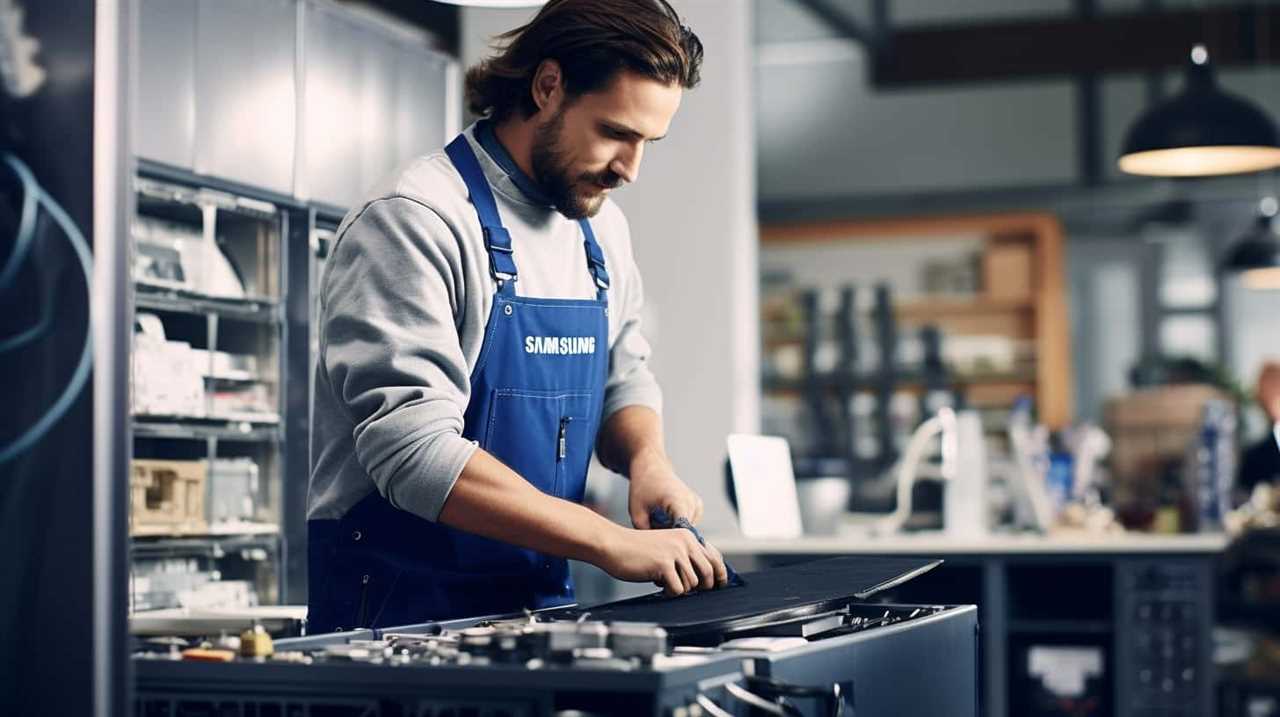
Imagine coming home to the aroma of a perfectly cooked meal, without having to spend hours in the kitchen. The smart slow cooker allows you to set the cooking time and temperature remotely using your smartphone, so you can have dinner ready when you walk through the door.
It also offers a variety of cooking modes, such as sautéing, steaming, and baking, making it a versatile addition to your kitchen arsenal. Whether you’re a busy professional or a culinary enthusiast, the smart slow cooker will revolutionize the way you cook.
Say goodbye to long hours spent slaving over the stove and hello to effortless, delicious meals.
Enhanced Flavor Infusion
Utilizing a smart slow cooker, we enhance flavor infusion in our dishes. With the help of advanced technology, our cooking experience is taken to a whole new level. Here are some ways we achieve flavor perfection:
- Smart Spice Rack: Our smart slow cooker comes equipped with a built-in smart spice rack, allowing us to easily access and incorporate a wide variety of spices into our dishes. This ensures that every bite is bursting with flavor.
- Flavor Infusion Techniques: Our smart slow cooker incorporates innovative flavor infusion techniques, such as steam infusion and sous vide cooking. These methods enhance the flavors of our ingredients, resulting in dishes that are rich, tender, and incredibly delicious.
- Precision Temperature Control: With precise temperature control, our smart slow cooker ensures that our dishes are cooked at the perfect temperature for maximum flavor extraction. This means that every ingredient is cooked to perfection, resulting in mouthwatering dishes.
- Customizable Cooking Settings: Our smart slow cooker allows us to customize our cooking settings, giving us the flexibility to experiment with different flavors and cooking techniques. This allows us to create unique and tasty dishes that truly reflect our culinary creativity.
Now, let’s move on to the next exciting smart kitchen gadget: the bluetooth food scale.
Bluetooth Food Scale
We love using a smart Bluetooth food scale to accurately measure ingredients for our recipes. This innovative kitchen gadget combines wireless connectivity with cooking accuracy, making it an essential tool for any home chef.
With a Bluetooth food scale, we can easily connect it to our smartphones or tablets, allowing us to conveniently track and record our measurements in real-time.
Gone are the days of guessing or estimating ingredient quantities. With a Bluetooth food scale, we can achieve precise measurements, ensuring that our recipes turn out perfectly every time. The scale uses advanced technology to deliver accurate readings, taking the guesswork out of cooking and baking.
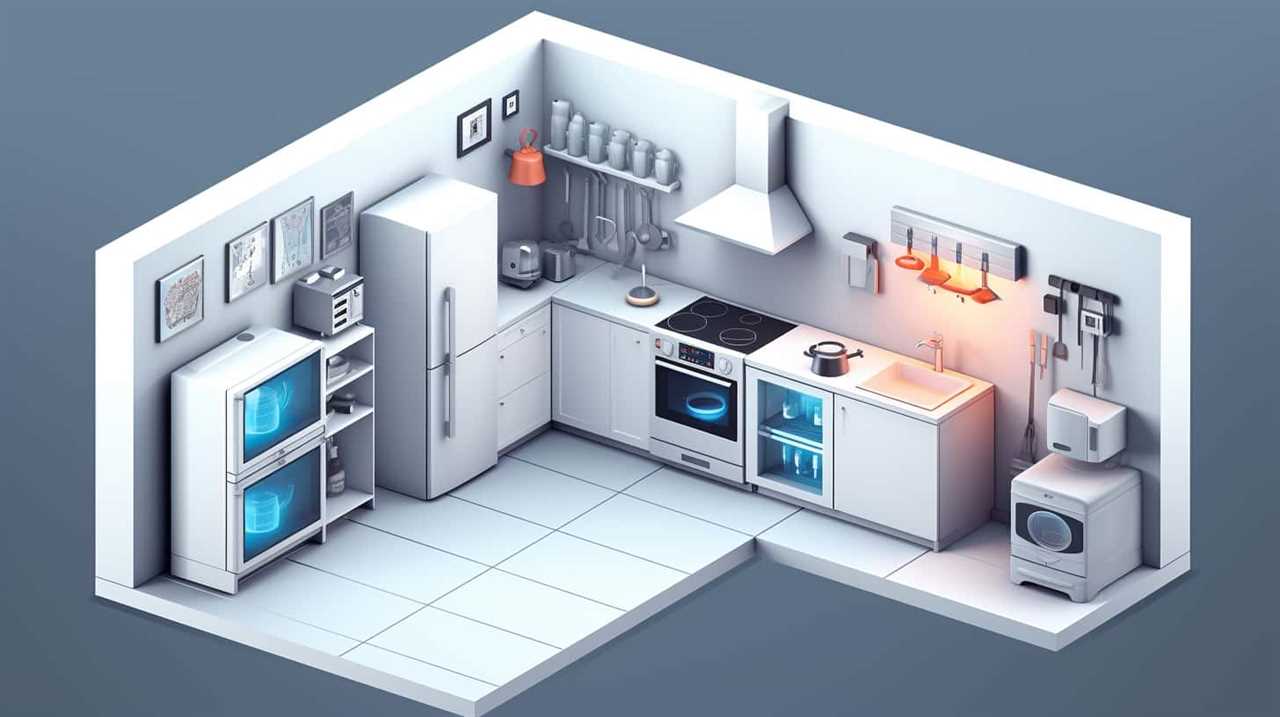
Not only does a Bluetooth food scale provide precise measurements, but it also offers additional features that enhance our cooking experience. Some models come with built-in timers and recipe apps, helping us stay organized and efficient in the kitchen. We can easily follow recipes and measure ingredients simultaneously, ensuring that everything is done with precision and in a timely manner.
As we transition into the next section about the ‘intelligent instant pot,’ we can see how the Bluetooth food scale complements this smart kitchen gadget. By accurately measuring ingredients with our Bluetooth food scale, we can ensure that our recipes are perfectly executed in our intelligent instant pot, creating delicious and flavorful meals with ease.
Intelligent Instant Pot
To get the most out of our cooking experience, let’s harness the power of the intelligent instant pot. This innovative kitchen gadget combines intelligent meal planning with automated pressure cooking to revolutionize the way we prepare meals. Here are four reasons why the intelligent instant pot should be a staple in every home chef’s kitchen:
- Effortless Meal Prep: With the intelligent instant pot, meal planning becomes a breeze. It has built-in sensors that can detect the type of ingredients you put in and suggest suitable cooking times and temperatures. Gone are the days of constantly monitoring the stove or oven – the instant pot takes care of everything.
- Time-Saving Convenience: The automated pressure cooking feature of the intelligent instant pot significantly reduces cooking time. It uses advanced algorithms to calculate the optimum pressure and temperature, resulting in faster cooking without sacrificing flavor or tenderness.
- Versatility and Customization: Whether you’re in the mood for a hearty stew or a delicate dessert, the intelligent instant pot has you covered. It offers a multitude of cooking modes, from slow cooking to sautéing, and even has a yogurt-making function. Plus, you can easily customize settings to suit your preferences.
- Smart Control and Connectivity: The intelligent instant pot can be controlled remotely using a smartphone app. Imagine being able to start cooking dinner on your way home from work, so it’s ready when you arrive. With its Wi-Fi and Bluetooth capabilities, this smart kitchen gadget keeps you connected and in control.
With the intelligent instant pot, you can elevate your cooking skills to the next level. It’s a game-changer that empowers home chefs to create delicious, healthy meals with ease and precision.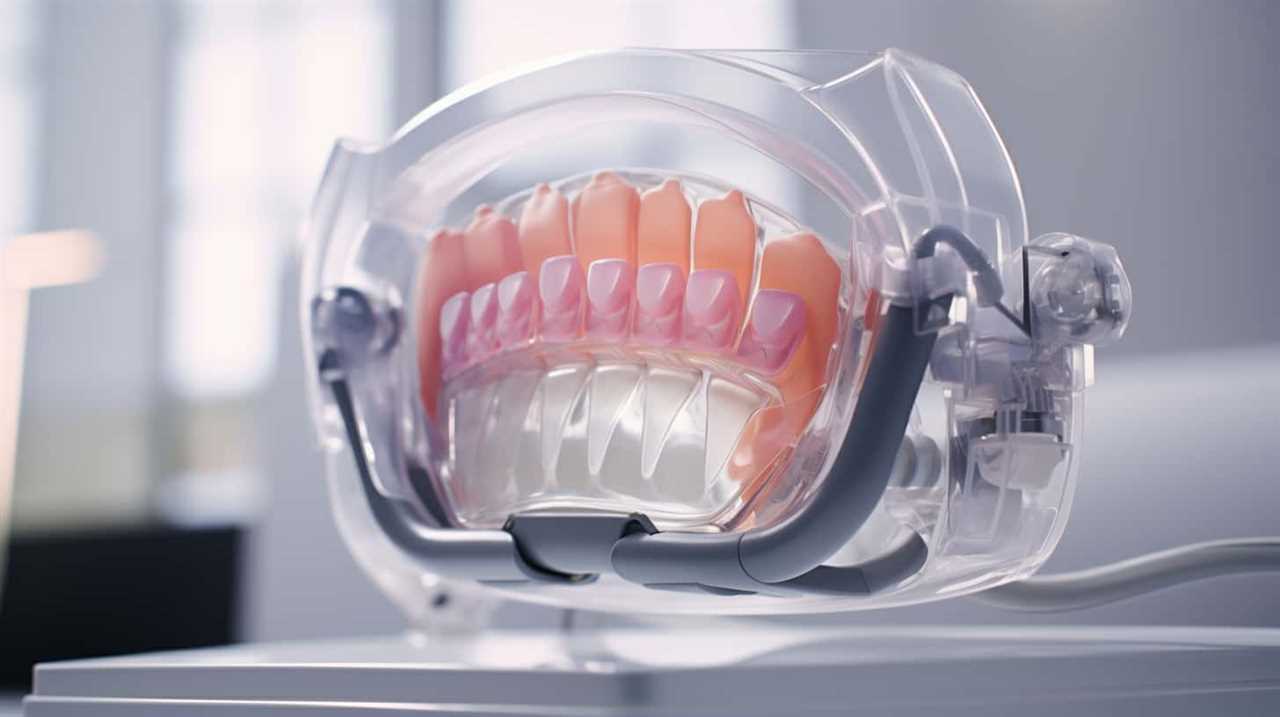
Smart Air Fryer
One essential kitchen gadget that every home chef needs is a smart air fryer. This innovative device combines the convenience of a traditional air fryer with the power of smart technology.
With a smart air fryer, you can enjoy all your favorite fried foods with a fraction of the oil and calories. It uses hot air circulation to cook food evenly and crisp it up to perfection. The smart features allow you to control and monitor the cooking process using your smartphone or voice commands. You can adjust the temperature, cooking time, and even receive notifications when your food is ready.
But the benefits of a smart air fryer go beyond just convenience. It also offers a range of healthy cooking options. You can use it to make crispy vegetables, juicy chicken breasts, or even bake a batch of guilt-free cookies. With its precise temperature control and rapid cooking capabilities, you can achieve delicious results every time. Plus, the smart technology ensures that you never overcook or burn your food.
Whether you’re a health-conscious chef or just looking for a convenient way to enjoy your favorite fried foods, a smart air fryer is a must-have kitchen gadget. It combines the best of both worlds – delicious taste and healthy cooking options.
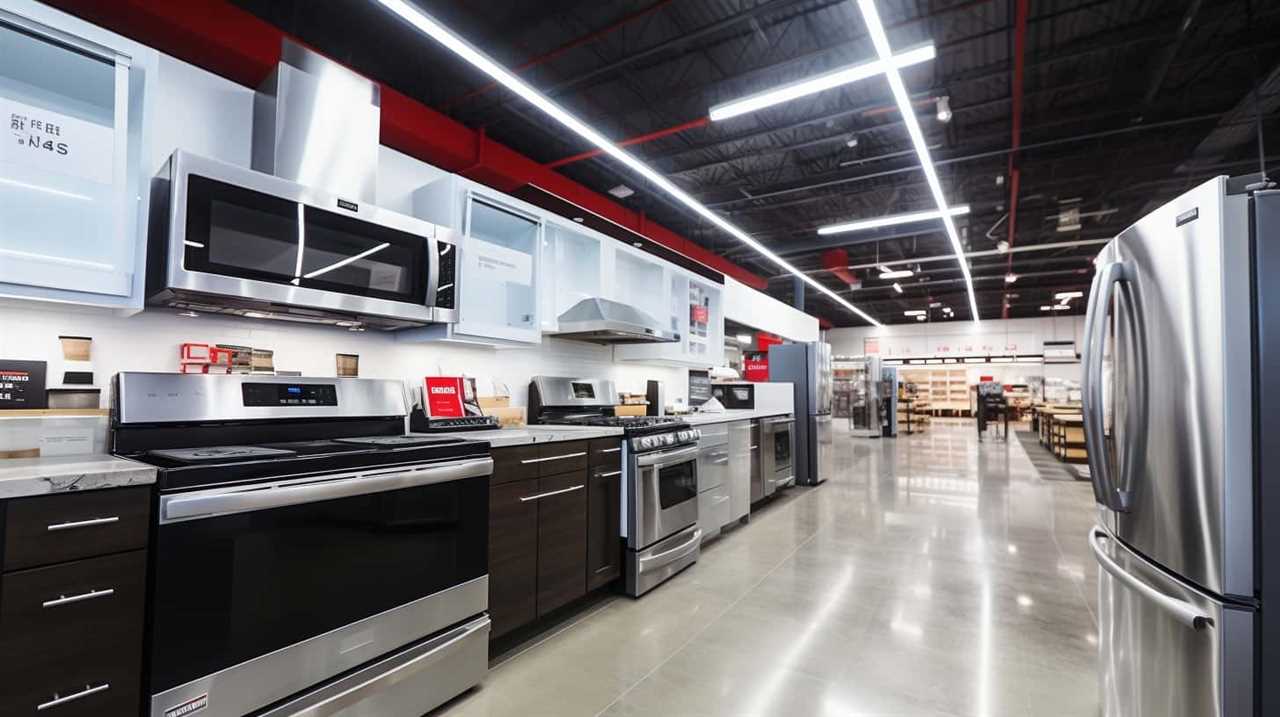
Automated Herb Garden
Continuing from the previous subtopic, let’s explore another essential kitchen gadget that every home chef needs: an automated herb garden.
With advancements in technology, smart herb gardens have become a game-changer for those who want to elevate their cooking skills. Here are some benefits of having an automated herb garden in your kitchen:
- Convenience: Imagine having fresh herbs at your fingertips, without the hassle of going to the store or dealing with wilted herbs. An automated herb garden allows you to grow a variety of herbs right in your kitchen, ensuring their freshness whenever you need them.
- Space-saving: If you have limited space in your kitchen, an automated herb garden is a perfect solution. These compact devices can fit on your countertop or even hang on the wall, providing you with a convenient and space-saving way to grow your favorite herbs.
- Efficiency: Smart herb gardens use automated indoor gardening techniques to optimize the growth of your herbs. With built-in sensors and timers, they ensure the right amount of light, water, and nutrients for your plants, resulting in healthier and more abundant harvests.
- Sustainability: By growing your own herbs, you reduce your reliance on store-bought produce, which often comes wrapped in plastic and travels long distances. An automated herb garden allows you to embrace a more sustainable lifestyle by cultivating fresh, organic herbs right at home.
Incorporating a smart herb garden into your kitchen not only enhances the flavors of your dishes but also brings a sense of pride and accomplishment as you master the art of growing your own ingredients. With these automated indoor gardening techniques, you can enjoy the benefits of fresh herbs all year round, elevating your culinary creations to new heights.
Frequently Asked Questions
How Much Energy Does a Smart Refrigerator Consume Compared to a Traditional Refrigerator?
Smart refrigerators consume significantly less energy compared to traditional refrigerators. This energy consumption comparison is one of the many benefits of owning a smart refrigerator.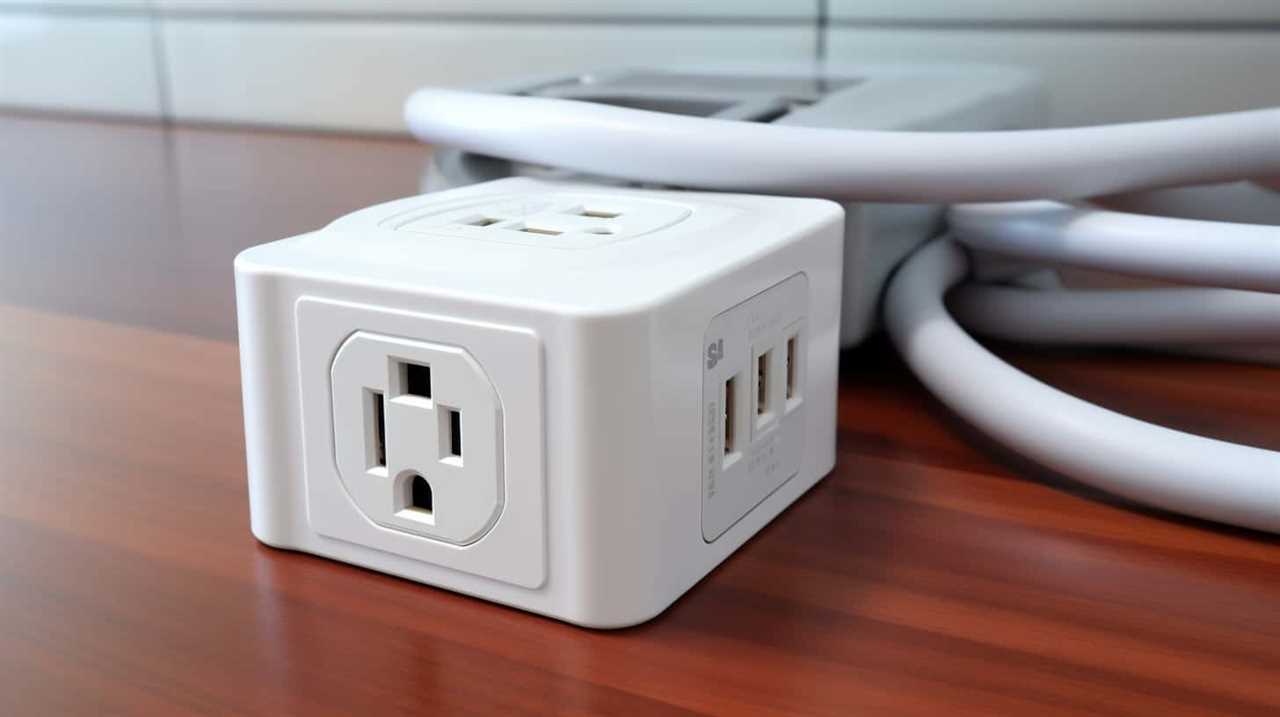
With advanced features like energy-saving modes, temperature control, and smart sensors, these gadgets optimize energy usage to keep your food fresh while minimizing electricity consumption.
Can a Voice-Activated Assistant Be Paired With Other Smart Kitchen Gadgets Like the Smart Coffee Maker or the Automated Herb Garden?
Yes, a voice-activated assistant can be paired with other smart kitchen gadgets like the smart coffee maker or the automated herb garden. This integration offers convenience and efficiency in the kitchen. With a simple voice command, you can brew your coffee or tend to your herbs without lifting a finger.
However, there are some drawbacks to using voice activated assistants in the kitchen, such as potential misinterpretation of commands or limited compatibility with certain gadgets.
What Is the Cooking Capacity of a Smart Slow Cooker?
The cooking capacity of a smart slow cooker is essential to know for any home chef. It allows us to plan and prepare meals efficiently.

With programmable settings, we can set the cooking time and temperature according to our recipe, ensuring perfectly cooked dishes every time. This feature is especially helpful for busy individuals who want to come home to a delicious meal without spending hours in the kitchen.
Can the Bluetooth Food Scale Be Connected to a Smartphone App for Tracking Nutritional Information?
Yes, the Bluetooth food scale can indeed be connected to a smartphone app for tracking nutritional information. This innovative feature allows us to easily monitor our food intake and make informed choices about our diet.
Additionally, by integrating the scale with a smart refrigerator, we can optimize our meal planning and reduce food waste. Not only does this save us time and money, but it also promotes sustainability by minimizing energy consumption.
It’s truly a game-changer for any home chef seeking mastery in the kitchen.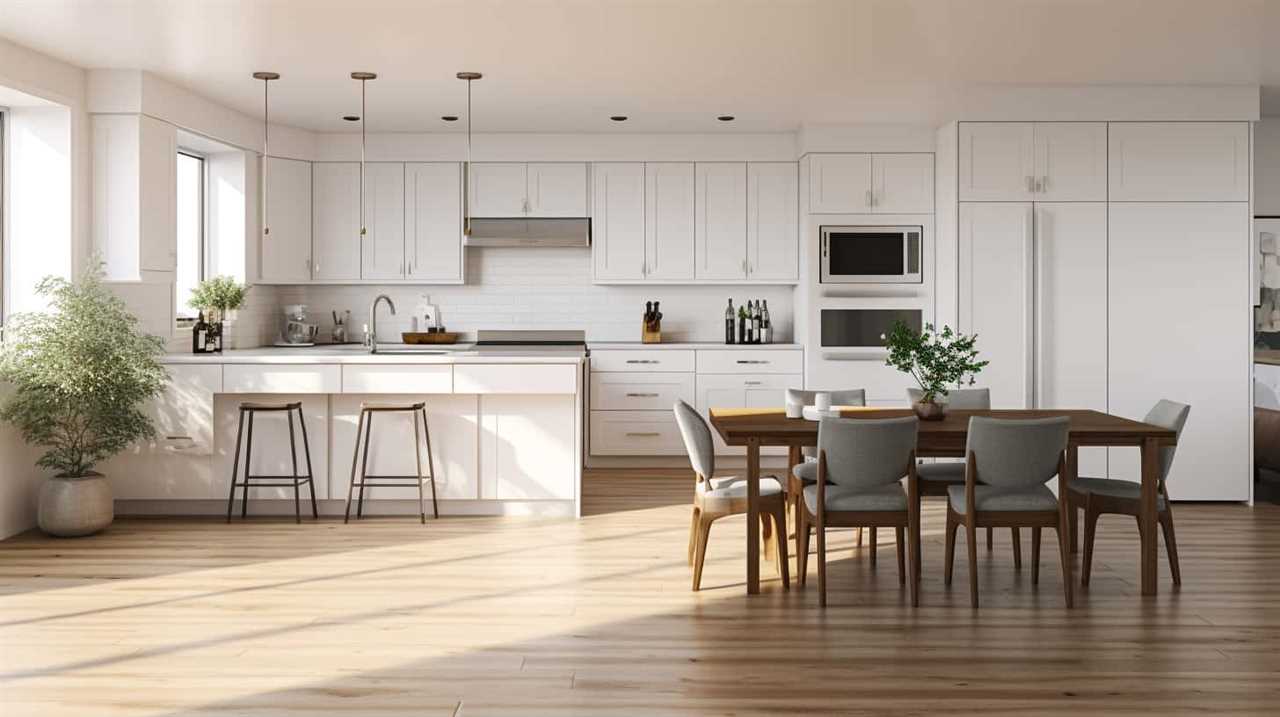
Are There Any Safety Features in Place for the Automated Pot Stirrer to Prevent Accidents or Spills?
When it comes to the automated pot stirrer, safety is a top priority. This innovative gadget is designed with built-in safety features to prevent accidents and spills. With its advanced technology, it ensures that the pot is securely attached and stable, minimizing the risk of any mishaps.
Additionally, the automated pot stirrer is equipped with sensors that can detect any irregularities or potential hazards, instantly alerting the user and taking necessary precautions. So you can confidently cook without worrying about any safety concerns.
Are Any of the Smart Kitchen Gadgets Environmentally Friendly?
Many smart home eco devices, including smart kitchen gadgets, are designed with sustainability in mind. These gadgets use energy-efficient technology and eco-friendly materials to reduce their environmental impact. From smart thermostats to composting appliances, there are plenty of options for creating an environmentally friendly kitchen.
Conclusion
In conclusion, these 11 smart kitchen gadgets are a game-changer for any home chef. With the convenience of a smart refrigerator, the efficiency of a Wi-Fi enabled oven, and the help of a voice-activated assistant, cooking has never been easier.
Don’t forget the smart coffee maker for that perfect cup of joe and the automatic pot stirrer to save you time and effort. So why wait? Embrace the future of cooking and upgrade your kitchen with these technologically-savvy gadgets.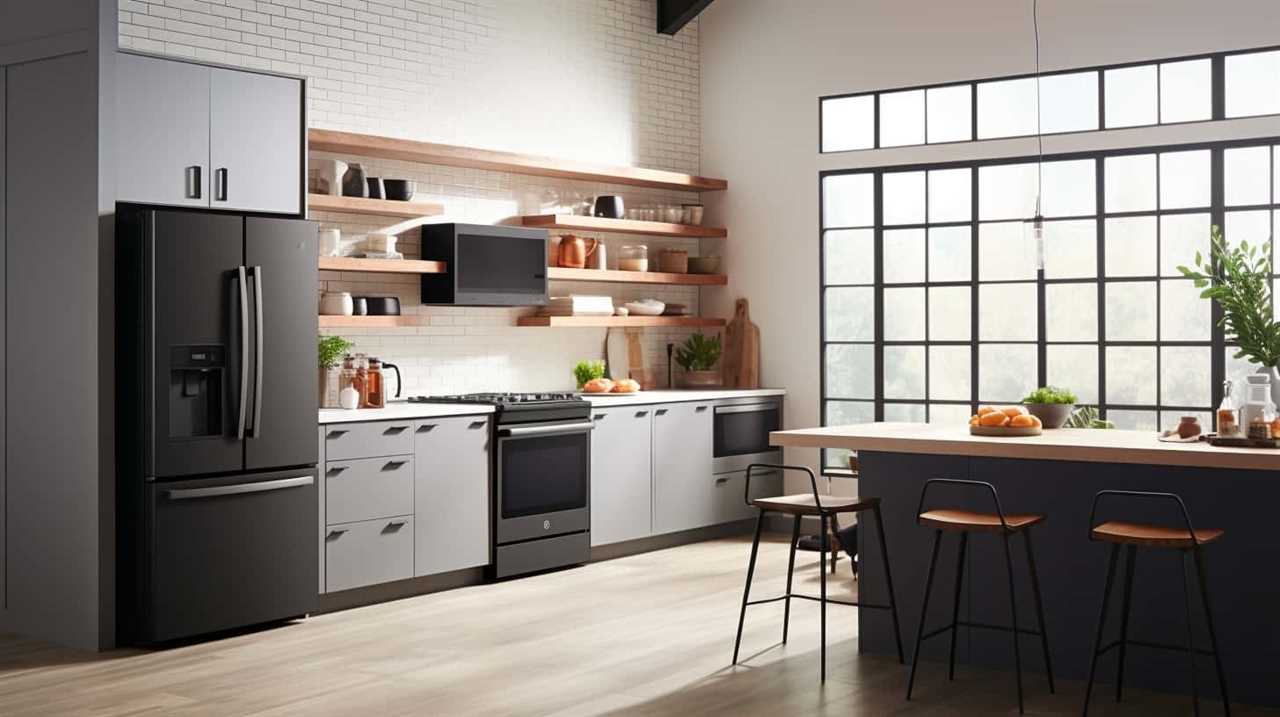
Remember, ‘The kitchen is the heart of the home.’
- About the Author
- Latest Posts
Introducing Charles, the Editor in Chief at ByRetreat, whose passion for interior design and editorial excellence elevates every remote workspace to new heights. With his keen eye for detail, impeccable taste, and expertise in design, Charles brings a wealth of knowledge and creativity to the ByRetreat team.
As the Editor in Chief of a renowned lifestyle blog, Charles has honed his skills in curating captivating content and staying up-to-date with the latest trends in interior design. His deep understanding of aesthetics and the power of storytelling through design enables him to create remote workspaces that are not only visually stunning but also rich in personality and meaning.
Garage Door Opener
Finding the Ideal Garage Door Opener Outlet Location
Get ready to discover the crucial factors determining the perfect placement for your garage door opener outlet.

When determining the best spot for a garage door opener socket, think of it as finding the missing piece to make your garage convenient and functional.
The placement of this outlet can significantly impact the ease of use and safety of your garage door opener system. So, where should it be positioned for optimal performance?
Let's explore the key factors that come into play to ensure a seamless experience with your garage door opener.
Key Takeaways
- Place the outlet around 9 feet above the door for optimal accessibility and functionality.
- Position the outlet slightly off-center to avoid interference with future insulation and maintenance.
- Ensure safety by locating the receptacle 3 feet back and 10 feet from the outside wall.
- Consult with professionals to guarantee proper placement and enhance usability.
Importance of Outlet Placement
Why is the placement of the outlet for your garage door opener crucial for optimal functionality and safety?
When it comes to the garage door opener, the electrical outlet placement plays a significant role in ensuring smooth operation and safety. By strategically locating the outlet around 9 feet above the door, slightly off-center, accessibility is enhanced without impeding future insulation or drywall modifications. This positioning also minimizes the risk of interference with the garage door opener's mechanisms, promoting seamless functionality.
Moreover, considering factors like ease of access, safety, and compliance with electrical regulations is essential for a secure and efficient garage door opener setup. Therefore, choosing the right spot for the outlet is paramount to guaranteeing the proper functioning and safety of your garage door opener.
It's not just about convenience; it's about ensuring that your garage door opener operates optimally while meeting essential safety standards and regulatory requirements.
Factors Affecting Outlet Location

Considering the layout and structure of your garage, several key factors influence the optimal placement of the outlet for your garage door opener. The door height plays a crucial role, with the ideal outlet location typically around 9 feet above the door for convenient access.
It's essential to position the outlet slightly to the side to avoid interference with future insulation and drywall work. Communicating with builders before installation can ensure the proper placement and prevent common mistakes that might arise.
Be cautious not to place the receptacle too far from the door as this could lead to issues with the opener cord reaching comfortably. Ensuring that the outlet location allows for smooth operation and easy maintenance is crucial for long-term convenience.
Safety Considerations for Outlet Placement
For optimal safety and convenience in outlet placement for your garage door opener, it's essential to position the receptacle 3 feet back from the end of the open garage door and approximately 10 feet from the outside wall. Placing the outlet in this specific location helps prevent any potential hazards that could arise from the door mechanisms or the opener's cord. By ensuring the receptacle is behind the opener, you maintain a clear pathway when the door is fully open, decreasing the risk of tripping or entanglement.
To further enhance safety, it's crucial to confirm that the cord length of the opener, typically between 3 to 4 feet, comfortably reaches the receptacle without any stretching or strain. If needed, use lumber to frame out a lower place to secure the cord of the opener to the receptacle adequately. Additionally, prioritize installing a Ground Fault Circuit Interrupter (GFCI) protected receptacle to add an extra layer of safety measures to your garage.
Convenience and Accessibility of Outlets

To ensure optimal convenience and accessibility for your garage door opener outlet, positioning it approximately 9 feet above the door allows for easy access during operation. This placement ensures that the outlet is within reach of the opener cord, reducing the risk of any operational issues. Additionally, consider situating the outlet slightly off-center to accommodate future insulation and drywall work, providing flexibility for any renovations.
When communicating with builders about the placement of the garage door opener outlet, make sure to convey the importance of having it positioned at the right height and distance from the door. Common mistakes, such as placing the receptacle too far from the door, can hinder optimal accessibility and convenience. By discussing the outlet location with builders beforehand, you can ensure that it is installed in a way that meets your needs and maximizes usability.
To illustrate further, here is a table outlining the key considerations for positioning your garage door opener outlet:
| Consideration | Description |
|---|---|
| Height Above Door | Approximately 9 feet for easy access during operation. |
| Distance from Opener Cord | Within reach to prevent operational issues. |
| Off-Center Placement | Slightly off-center to accommodate future insulation and drywall work. |
| Communication with Builders | Discuss with builders to determine the best outlet placement before installation. |
| Avoiding Common Mistakes | Ensure the receptacle is not placed too far from the door for optimal accessibility. |
Tips for Optimal Garage Door Opener Outlet Location
When determining the ideal location for your garage door opener outlet, prioritize accessibility and functionality by placing it at a height of around 9 feet above the door. This placement ensures easy reach and connection to the opener cord, facilitating seamless operation.
To optimize your garage door opener outlet location, consider the following tips:
- Positioning: Place the outlet slightly to the side to avoid interference with future insulation and drywall work.
- Consultation: Communicate with builders or professionals before installation to ensure proper placement and avoid common mistakes.
- Reachability: Avoid placing the receptacle too far from the door to prevent issues with the opener cord reaching the power source.
- Functionality: Ensure the outlet location allows for easy access and connection to maintain a smooth and efficient operation of your garage door opener.
Frequently Asked Questions
Where Should a Garage Door Opener Outlet Be Placed?
We recommend placing a garage door opener outlet near the ceiling, around 9 feet above the door for easy access. Positioning it slightly to the side can prevent interference and future issues with insulation or drywall.
Opt for a location a few feet above the door height and off-center for practical accessibility. Avoid surface mounting and ensure it's within reach of the opener cord.
Consult professionals for proper placement to avoid common mistakes.
Where Should Outlets Be Placed in a Garage?
When outfitting a garage with outlets, strategic placement is key. Consider functionality and convenience. Ensure outlets are accessible and comply with safety standards to avoid interference with garage door openers.
Optimal positioning is crucial for smooth operation. By placing outlets thoughtfully, we guarantee efficiency and ease of access. Properly spaced outlets contribute to a well-organized, functional workspace.
Take care in positioning outlets for a seamless garage experience.
Can the Garage Door Opener Be on Same Circuit as Garage Receptacles?
Yes, the garage door opener can be on the same circuit as the garage receptacles. This setup is convenient for installation and operation, simplifying wiring and electrical planning.
It's a common practice in residential settings to share the circuit between the garage door opener and receptacles. However, it's crucial to consult with an electrician to ensure the circuit can handle the combined load of both devices effectively.
How Do I Program My Garage Door Opener Outlet?
We've programmed many garage door opener outlets! Locate the 'Learn' button on the unit. Press and release it, then quickly hit the remote's button to program it.
Wait for the light to flash, showing successful programming. Test the remote for proper operation.
Always follow the manufacturer's instructions for specific steps. It's as easy as that to program your garage door opener outlet.
Conclusion
In conclusion, finding the ideal location for your garage door opener outlet is like finding the perfect key for a locked door – it unlocks convenience and safety.
By considering factors such as placement, safety measures, and accessibility, you can ensure smooth operation and peace of mind.
Remember, consulting with a professional and following best practices can guarantee a seamless experience every time you open your garage door.
- About the Author
- Latest Posts
Introducing Ron, the home decor aficionado at ByRetreat, whose passion for creating beautiful and inviting spaces is at the heart of his work. With his deep knowledge of home decor and his innate sense of style, Ron brings a wealth of expertise and a keen eye for detail to the ByRetreat team.
Ron’s love for home decor goes beyond aesthetics; he understands that our surroundings play a significant role in our overall well-being and productivity. With this in mind, Ron is dedicated to transforming remote workspaces into havens of comfort, functionality, and beauty.

Are you prepared to elevate your dental health? Check out our 12 tips for utilizing Bluetooth dental health gadgets!
These cutting-edge devices combine the power of technology with the importance of oral hygiene. We, as a team of experts, have compiled this comprehensive guide to help you master the world of Bluetooth dental tools.
From choosing the right gadget to maximizing its effectiveness, we’ve got you covered. Say goodbye to traditional dental care methods and embrace the future of oral health.
With our tips, you’ll be able to seamlessly integrate Bluetooth dental gadgets into your daily routine and enhance communication with your dentist. Get ready to achieve the smile of your dreams with the help of these innovative devices.
Key Takeaways
- Improved oral hygiene
- Real-time feedback and guidance
- Personalized recommendations for optimal brushing technique
- Enhanced portability for on-the-go use
Benefits of Bluetooth Dental Health Gadgets
The benefits of Bluetooth dental health gadgets include improved oral hygiene and enhanced monitoring of dental health. These gadgets are designed to help individuals in improving their brushing techniques and maintaining good oral health. By connecting to a smartphone or a tablet, Bluetooth dental health gadgets provide real-time feedback and guidance, ensuring that users are brushing their teeth effectively.
One of the main advantages of these gadgets is the ability to improve brushing techniques. Many people are unaware of the correct way to brush their teeth, leading to ineffective cleaning and potential oral health issues. Bluetooth dental health gadgets can track the movement and pressure applied during brushing, offering personalized recommendations for optimal brushing technique. This helps users to develop better brushing habits and achieve more thorough cleaning.
Another significant benefit is the remote dental monitoring feature offered by these gadgets. Dental health professionals can remotely monitor the brushing habits of their patients through a connected app. This allows for personalized advice and recommendations to be provided, ensuring that patients are maintaining good oral hygiene practices between dental visits.
How to Choose the Right Bluetooth Dental Tool
When choosing a Bluetooth dental tool, there are two important factors to consider: compatibility with your devices and ease of use.
It’s crucial to ensure that the tool you choose is compatible with your smartphone or other devices, so that you can easily connect and use it.
Additionally, opting for a tool that’s user-friendly and easy to navigate will help maximize its effectiveness and make your dental routine more efficient.
Compatibility With Devices
We found that researching the compatibility of Bluetooth dental tools with our devices was crucial in selecting the right tool for our dental health needs.
Bluetooth compatibility is an essential factor to consider when choosing a dental gadget, as it ensures seamless communication between the tool and our devices. It allows us to track our dental health progress, receive real-time feedback, and access personalized recommendations for improving our oral care routine.

However, it’s important to note that compatibility issues may arise, leading to troubleshooting problems. To avoid such issues, it’s recommended to check the compatibility requirements of the dental tool with our devices before making a purchase. This will help us ensure a smooth and hassle-free experience with our Bluetooth dental health gadget.
Moving forward, let’s explore the next important aspect of these tools – their ease of use.
Ease of Use
To ensure a user-friendly experience, it’s important to consider the ease of use when selecting the right Bluetooth dental tool for our needs.
When it comes to improving accessibility and usability, choosing a dental tool with a user-friendly design is crucial. Look for devices that have intuitive interfaces and easy-to-use controls. Consider tools that offer clear and concise instructions, making it easy for users to understand and operate them effectively.
Additionally, opt for devices with ergonomic designs that are comfortable to hold and use for extended periods. This will help minimize user fatigue and increase overall satisfaction with the tool.
Understanding the Importance of Bluetooth Connectivity
Understanding the importance of Bluetooth connectivity is crucial when it comes to dental health gadgets. By utilizing Bluetooth technology, these devices offer enhanced dental care by providing real-time data and personalized feedback.
This wireless convenience allows for easy usage and seamless integration with smartphones and other devices, making it a convenient and user-friendly option for monitoring and tracking oral health.
Enhanced Dental Care
Bluetooth connectivity is crucial for improving dental care through the use of innovative gadgets. By integrating wireless technology into dental health devices, we can enhance oral hygiene practices and ensure better dental care.
The benefits of wireless technology in dental gadgets are manifold. Firstly, it allows for real-time monitoring and tracking of oral health, providing accurate data that can be analyzed by dental professionals.
Secondly, Bluetooth connectivity enables seamless communication between devices, allowing for personalized feedback and guidance on oral hygiene routines. This promotes a more effective and targeted approach to dental care.
Additionally, wireless technology facilitates the integration of dental gadgets with smartphone applications, making it easier for users to track and manage their oral health.
Wireless Convenience Benefits
How can Bluetooth connectivity enhance our dental health gadgets?
Bluetooth connectivity offers a range of wireless connectivity advantages that greatly contribute to the convenience of Bluetooth gadgets. Here are five key benefits of Bluetooth connectivity for dental health gadgets:
- Seamless syncing: Bluetooth allows for effortless synchronization between your dental health gadget and your smartphone or other devices, ensuring that your data is always up to date.
- Hands-free operation: With Bluetooth connectivity, you can control your dental health gadget without the need for physical buttons or touchscreens, allowing for a more hygienic and convenient experience.
- Remote monitoring: Bluetooth-enabled dental health gadgets can transmit data in real-time to your smartphone or computer, allowing you to track your oral health progress even when you’re not near your gadget.
- Enhanced portability: Bluetooth gadgets are typically compact and lightweight, making them easy to carry and use on the go.
- Multi-device compatibility: Bluetooth connectivity enables your dental health gadget to connect with multiple devices simultaneously, providing flexibility and convenience for users with multiple devices.
With these wireless convenience benefits, Bluetooth connectivity significantly enhances the overall user experience of dental health gadgets.
Improved Data Tracking
We have seen a significant improvement in data tracking with the introduction of Bluetooth connectivity in dental health gadgets. This technology has revolutionized the way we monitor our oral health. With improved accuracy and real-time monitoring, Bluetooth dental gadgets allow us to track our dental hygiene habits more effectively.
By connecting these gadgets to our smartphones or other devices, we can easily access and analyze the data collected from our brushing habits, gum health, and more. This level of data tracking provides valuable insights into our oral health, helping us identify areas for improvement and track progress over time.
Now, let’s explore the top features to look for in Bluetooth dental gadgets to make the most of this advanced data tracking capability.
Top Features to Look for in Bluetooth Dental Gadgets
When choosing Bluetooth dental health gadgets, it’s important to consider the top features that will enhance our oral care routine. Here are some key features to look for:
- Bluetooth Connectivity: Bluetooth-enabled dental gadgets offer the benefits of wireless connectivity, allowing us to easily sync our device with our smartphones or tablets. This enables us to access real-time data and receive notifications for reminders and updates.
- Data Tracking: The importance of data tracking can’t be overstated. Look for gadgets that can track and store essential dental health information such as brushing time, pressure applied, and areas of the mouth that need more attention. This data can provide valuable insights into our brushing habits and help us make improvements.
- Interactive Apps: Choose gadgets that come with interactive mobile applications. These apps provide personalized guidance, oral care tips, and progress tracking, making our oral care routine more engaging and effective.
- Timers and Reminders: Look for gadgets that have built-in timers and reminders to ensure we brush for the recommended two minutes and replace our brush heads regularly. These features help us maintain good oral hygiene habits.
- Compatibility with Multiple Users: If sharing the gadget with family members, opt for devices that can track and store data for multiple users. This ensures that each user can have their own personalized oral care routine.
Considering these top features will help us choose Bluetooth dental health gadgets that optimize our oral care routine.
Now, let’s explore some tips for using these gadgets effectively.
Tips for Using Bluetooth Dental Health Gadgets Effectively
To effectively utilize Bluetooth dental health gadgets, it’s crucial to ensure proper syncing and calibration of the device. This ensures accurate and reliable data collection, allowing you to track and improve your dental habits effectively.
To maximize device performance, start by syncing your gadget with a compatible mobile app or software. Follow the manufacturer’s instructions carefully to ensure a successful connection.
Once synced, calibrate the device according to your specific dental needs. This may involve setting personalized targets for brushing time, pressure, or technique.
Regularly check for firmware updates to ensure your device is running the latest software, which can enhance its performance and functionality.
It’s also important to clean and maintain your gadget regularly to avoid any performance issues. Refer to the manufacturer’s guidelines for cleaning instructions and best practices.
Common Misconceptions About Bluetooth Dental Tools
There are several common misconceptions about Bluetooth dental tools that we need to address.
First, it’s important to understand that Bluetooth technology can actually improve oral hygiene by allowing for seamless communication between dental devices and smartphone apps.
Secondly, wireless technology enhances dental care by providing real-time data and personalized feedback to users.
Lastly, we’ll debunk some of the myths surrounding dental gadgets to ensure that users have accurate information about their benefits and limitations.
Bluetooth Improves Oral Hygiene
Although there are common misconceptions about Bluetooth dental tools, we’ve found that they significantly improve oral hygiene. Here are five reasons why Bluetooth dental tools are beneficial for your oral health:
- Improved brushing techniques: Bluetooth dental tools provide real-time feedback on your brushing technique, helping you achieve a more thorough clean.
- Oral health tracking: These tools can track your brushing habits and provide data on your oral health, allowing you to make informed decisions about your dental care routine.
- Timely reminders: Bluetooth dental tools can send reminders to brush, floss, and rinse, ensuring that you maintain a consistent oral hygiene routine.
- Personalized recommendations: Based on your brushing data, these tools can provide personalized recommendations for toothpaste, toothbrushes, and other oral care products.
- Motivation and accountability: Bluetooth dental tools can gamify oral hygiene, making it more enjoyable and encouraging you to maintain good oral health habits.
Wireless Technology Enhances Dental Care
We have encountered several misconceptions about Bluetooth dental tools that hinder their recognition as a valuable wireless technology for enhancing dental care.
One common misconception is that wireless toothbrushes are just a gimmick. However, these toothbrushes use Bluetooth technology to connect to a smartphone app, providing real-time feedback on brushing habits and helping users improve their oral hygiene.
Another misconception is that a Bluetooth toothpaste dispenser is unnecessary. In reality, this device ensures that the right amount of toothpaste is dispensed, reducing waste and promoting proper dental hygiene. It also helps users track their toothpaste usage, ensuring they never run out.
Myths About Dental Gadgets
Our experience with Bluetooth dental tools has revealed common misconceptions surrounding their effectiveness. Let’s debunk these myths and shed light on the benefits of using Bluetooth in dental care:
- Bluetooth dental gadgets aren’t just a fad; they provide real-time data and accurate measurements for better dental health monitoring.
- Contrary to popular belief, Bluetooth dental tools are easy to use and integrate seamlessly into your oral care routine.
- Some people think that Bluetooth dental gadgets are expensive, but they offer long-term cost savings by enabling early detection and prevention of dental issues.
- Another misconception is that Bluetooth dental tools are only for professionals. In reality, they empower individuals to take control of their oral health and make informed decisions.
- Lastly, some may worry about the security and privacy of Bluetooth dental gadgets. However, manufacturers prioritize data protection, ensuring that your information remains confidential.
Troubleshooting Common Issues With Bluetooth Dental Gadgets
Identifying and resolving common issues with Bluetooth dental gadgets can significantly improve their functionality and user experience. Troubleshooting connection issues and optimizing battery life are two key areas to focus on when encountering problems with these devices. Here are some tips to help you troubleshoot and overcome these issues:
| Common Issues | Possible Solutions |
|---|---|
| Connection drops frequently | Ensure that the Bluetooth device is within range and there are no obstructions interfering with the signal. Try reconnecting the device or resetting the Bluetooth settings. |
| Poor sound quality during calls | Check if the microphone and speaker are properly aligned. Adjust the volume settings on both the device and the dental gadget. If the problem persists, try restarting both devices. |
| Short battery life | Reduce the usage of power-intensive features such as continuous monitoring or high volume settings. Disconnect the Bluetooth connection when not in use. Consider replacing the battery if it is old or not holding a charge effectively. |
How Bluetooth Technology Enhances Dental Health Monitoring
When it comes to enhancing dental health monitoring, Bluetooth technology plays a crucial role. Bluetooth dental technology has revolutionized the way dentists and patients can monitor oral health. Here are five ways Bluetooth technology enhances dental health monitoring:
- Real-time data: Bluetooth dental devices can transmit real-time data to a connected smartphone or computer, allowing dentists to monitor patients’ oral health instantly.
- Remote monitoring: With Bluetooth dental monitoring, dentists can remotely monitor patients’ oral health without the need for in-person visits, making it more convenient for both parties.
- Continuous tracking: Bluetooth dental devices can continuously track various parameters such as brushing habits, pressure applied during brushing, and even the presence of harmful bacteria, providing a comprehensive picture of oral health.
- Personalized feedback: Bluetooth dental technology enables dentists to provide personalized feedback and recommendations based on the data gathered, helping patients improve their oral hygiene practices.
- Early detection: By monitoring oral health in real-time, Bluetooth dental monitoring devices can help dentists detect potential issues early on, allowing for prompt intervention and treatment.
Bluetooth dental technology has transformed the way we monitor dental health, providing dentists with valuable insights and patients with convenient and personalized care. With its ability to transmit real-time data, enable remote monitoring, and provide continuous tracking, Bluetooth technology is undoubtedly a game-changer in dental health monitoring.
The Future of Bluetooth-Enabled Dental Health Gadgets
As we look ahead to the future of Bluetooth-enabled dental health gadgets, it’s clear that these innovative devices will continue to revolutionize the way we monitor and maintain oral health. With ongoing advancements in technology, we can expect exciting developments in the field of dental health monitoring.
One potential future advancement is the integration of artificial intelligence (AI) into Bluetooth-enabled dental health gadgets. AI algorithms could analyze data collected by these devices and provide personalized recommendations for improving oral hygiene. This could help individuals optimize their dental care routines and prevent future oral health issues.
Another area of future advancement is the incorporation of augmented reality (AR) technology. AR could enhance the user experience by providing real-time visual feedback during brushing or flossing, ensuring that individuals are maintaining proper technique. This could be particularly beneficial for children or people with limited dexterity.
While the future of Bluetooth-enabled dental health gadgets appears promising, there are also potential drawbacks to consider. Privacy and security concerns may arise as these devices collect and transmit personal health data. It will be crucial for manufacturers to prioritize data protection and ensure robust security measures are in place.
Bluetooth Dental Gadgets for Children’s Oral Care
In our exploration of the future of Bluetooth-enabled dental health gadgets, we can now turn our attention to the specific application of these devices for children’s oral care. Bluetooth dental gadgets aren’t only designed for adults but also cater to the needs of children, ensuring their oral health is taken care of in a fun and engaging way.
Here are some key features of Bluetooth dental gadgets for children:
- Interactive brushing experience: These gadgets use Bluetooth toothbrush technology to connect to a mobile app, transforming brushing into a game or adventure, making it more enjoyable for children.
- Tracking and monitoring: Parents can track their child’s brushing habits and receive real-time updates on their progress through the app. This helps in ensuring that children brush for the recommended duration and reach all areas of their mouth.
- Rewards and incentives: Some Bluetooth dental gadgets have built-in reward systems, where children earn points or badges for brushing correctly. This motivates them to maintain good oral hygiene habits.
- Educational content: The mobile apps accompanying these gadgets often include educational videos and tips, teaching children about the importance of oral hygiene and proper brushing techniques.
- Parental control: Parents can have control over the settings and features of the Bluetooth dental gadgets, ensuring that the devices are safe and appropriate for their children’s age.
Bluetooth dental gadgets for children provide an innovative and effective way to instill good oral hygiene habits from a young age, making dental care a positive experience for children.
Integrating Bluetooth Dental Gadgets Into Your Daily Routine
To seamlessly incorporate Bluetooth dental gadgets into our daily routine, we can actively engage with their features and make oral care a priority for our whole family. Bluetooth toothbrushes, in particular, offer numerous benefits that can enhance our wellness routine.
These gadgets connect to our smartphones or other devices, allowing us to track our brushing habits and receive real-time feedback on our technique. By incorporating these gadgets into our daily routine, we can ensure that we’re brushing for the recommended two minutes and reaching all areas of our mouth effectively. Additionally, Bluetooth toothbrushes often come with built-in timers and reminders, making it easier for us to stay consistent with our oral care routine.
By involving our whole family in this process, we can create a positive and supportive environment that encourages good dental habits for everyone. Involving our children in the use of Bluetooth dental gadgets can make oral care more engaging and fun, helping them develop good oral hygiene habits from an early age.
Enhancing Communication With Your Dentist Using Bluetooth Tools
One important way to enhance communication with our dentist is by utilizing Bluetooth tools. These innovative devices can greatly improve dental appointments and facilitate remote dental consultations. Here are five ways Bluetooth tools can enhance communication with your dentist:
- Real-time communication: Bluetooth tools allow for seamless and instant communication between patients and dentists. Whether it’s sending images of your teeth or discussing concerns, Bluetooth tools enable quick and efficient communication.
- Remote consultations: With Bluetooth tools, you can have virtual consultations with your dentist without having to physically visit the dental clinic. This saves time and allows for more convenient appointments.
- Monitoring oral health: Bluetooth-enabled devices can monitor and track your oral health, providing valuable data to your dentist. This information helps them identify any potential issues and provide personalized advice during your appointments.
- Sharing dental records: Bluetooth tools make it easy to share dental records and X-rays with your dentist. This ensures that your dentist has access to accurate and up-to-date information, enabling them to provide better care.
- Treatment reminders: Bluetooth tools can send reminders for dental appointments and medication schedules. This helps ensure that you never miss an important dental visit or forget to take necessary medication.
Are Bluetooth Dental Health Gadgets Effective for Allergy Sufferers?
Bluetooth dental health gadgets may not directly impact allergy sufferers, but using a top HEPA vacuum can help eliminate allergens in the environment. Keeping the home clean with one of the top HEPA vacuums for allergy sufferers can reduce exposure to allergens and improve overall dental health.
Frequently Asked Questions
Can Bluetooth Dental Health Gadgets Be Used by Individuals With Braces or Other Orthodontic Appliances?
Bluetooth dental health gadgets can be used by individuals with braces or other orthodontic appliances, but their effectiveness may be limited. These gadgets can help monitor oral hygiene habits and provide feedback, but they may not be able to accurately track certain areas around the braces. Additionally, there’s a risk of damaging the gadgets or braces if they come into contact.
It’s important to consult with your orthodontist before using these gadgets to ensure they’re safe and appropriate for your specific situation.
Are There Any Specific Precautions or Guidelines to Follow When Using Bluetooth Dental Health Gadgets?
When using Bluetooth dental health gadgets, there are important precautions and guidelines to follow. To ensure optimal usage, it’s crucial to adhere to these recommendations.
By taking these precautions, you can maximize the benefits of these gadgets while minimizing any potential risks. Following the guidelines will help you maintain good oral hygiene and achieve better dental health.

Do Bluetooth Dental Health Gadgets Require a Separate App or Software to Function?
Bluetooth dental health gadgets don’t require a separate app or software to function. These devices utilize Bluetooth technology to connect directly to your smartphone or other compatible device.
Once connected, you can easily track and monitor your dental health using the dedicated app provided by the manufacturer. This app allows you to view real-time data, set reminders, and access personalized recommendations for improving your oral hygiene.
It’s a convenient and efficient way to take control of your dental health.
Can Bluetooth Dental Health Gadgets Be Used by Individuals With Dental Implants or Other Dental Prosthetics?
Bluetooth dental health gadgets can indeed be used by individuals with dental implants or other dental prosthetics. These gadgets have the potential to greatly improve oral hygiene by providing real-time feedback and personalized recommendations.
However, there are some advantages and disadvantages to consider. On one hand, Bluetooth dental health gadgets can help individuals with dental implants maintain proper oral care.
On the other hand, the gadgets may not be as effective in detecting plaque or other dental issues in hard-to-reach areas around the implants.
Are Bluetooth Dental Health Gadgets Compatible With All Types of Smartphones and Devices?
Bluetooth dental health gadgets are compatible with a wide range of smartphones and devices, making them versatile and convenient to use. They can also be used with non-smartphone devices, allowing more people to benefit from their features.
The benefits of using these gadgets include real-time feedback on brushing techniques, tracking of brushing habits, and reminders for regular dental check-ups. Incorporating Bluetooth technology into dental health gadgets enhances their functionality and improves oral hygiene practices.
Conclusion
In conclusion, with the help of Bluetooth dental health gadgets, achieving a dazzling smile has never been easier. These innovative tools not only provide numerous benefits and features but also enhance communication with your dentist.
So, why not dive into the world of Bluetooth dental gadgets and let them take your oral care routine to new heights? It’s like having a personal dental assistant right at your fingertips, guiding you towards a healthier, happier mouth.
Say goodbye to dental woes and hello to a brighter future!
- About the Author
- Latest Posts
Introducing Charles, the Editor in Chief at ByRetreat, whose passion for interior design and editorial excellence elevates every remote workspace to new heights. With his keen eye for detail, impeccable taste, and expertise in design, Charles brings a wealth of knowledge and creativity to the ByRetreat team.
As the Editor in Chief of a renowned lifestyle blog, Charles has honed his skills in curating captivating content and staying up-to-date with the latest trends in interior design. His deep understanding of aesthetics and the power of storytelling through design enables him to create remote workspaces that are not only visually stunning but also rich in personality and meaning.
-

 Decor1 week ago
Decor1 week agoMaximalist Decor Explained: Embrace More Style
-

 Vetted4 weeks ago
Vetted4 weeks ago15 Best Drip Irrigation Systems to Keep Your Garden Thriving
-

 Vetted2 weeks ago
Vetted2 weeks ago15 Best Foot Massagers for Neuropathy to Soothe Your Feet and Relieve Discomfort
-

 Vetted3 weeks ago
Vetted3 weeks ago15 Best Sports Laundry Detergents for Keeping Your Activewear Fresh and Clean
-

 Vetted3 weeks ago
Vetted3 weeks ago15 Best Tall Toilets for Seniors That Combine Comfort and Safety
-

 Vetted4 weeks ago
Vetted4 weeks ago15 Best Dish Scrubbers to Keep Your Kitchen Sparkling Clean
-

 Vetted24 hours ago
Vetted24 hours ago15 Best Cleaners for Fiberglass Showers to Keep Your Bathroom Sparkling Clean
-

 Decor4 weeks ago
Decor4 weeks agoWhat Is Eclectic Home Decor

























